Marine Heat Waves anomaly profiles
Marguerite Larriere & Jens Daniel Müller
13 June, 2024
Last updated: 2024-06-13
Checks: 7 0
Knit directory:
bgc_argo_r_argodata/analysis/
This reproducible R Markdown analysis was created with workflowr (version 1.7.0). The Checks tab describes the reproducibility checks that were applied when the results were created. The Past versions tab lists the development history.
Great! Since the R Markdown file has been committed to the Git repository, you know the exact version of the code that produced these results.
Great job! The global environment was empty. Objects defined in the global environment can affect the analysis in your R Markdown file in unknown ways. For reproduciblity it’s best to always run the code in an empty environment.
The command set.seed(20211008) was run prior to running
the code in the R Markdown file. Setting a seed ensures that any results
that rely on randomness, e.g. subsampling or permutations, are
reproducible.
Great job! Recording the operating system, R version, and package versions is critical for reproducibility.
Nice! There were no cached chunks for this analysis, so you can be confident that you successfully produced the results during this run.
Great job! Using relative paths to the files within your workflowr project makes it easier to run your code on other machines.
Great! You are using Git for version control. Tracking code development and connecting the code version to the results is critical for reproducibility.
The results in this page were generated with repository version e0e5696. See the Past versions tab to see a history of the changes made to the R Markdown and HTML files.
Note that you need to be careful to ensure that all relevant files for
the analysis have been committed to Git prior to generating the results
(you can use wflow_publish or
wflow_git_commit). workflowr only checks the R Markdown
file, but you know if there are other scripts or data files that it
depends on. Below is the status of the Git repository when the results
were generated:
Ignored files:
Ignored: .RData
Ignored: .Rproj.user/
Ignored: analysis/poster_profile_argo.png
Untracked files:
Untracked: analysis/draft.Rmd
Untracked: load_argo_core_output.txt
Untracked: poster_profile_argo.png
Unstaged changes:
Modified: analysis/CESM_comparison.Rmd
Deleted: analysis/MHWs_categorisation.Rmd
Modified: analysis/_site.yml
Modified: analysis/child/cluster_analysis_base.Rmd
Modified: analysis/coverage_maps_North_Atlantic.Rmd
Modified: analysis/load_broullon_DIC_TA_clim.Rmd
Modified: code/Workflowr_project_managment.R
Modified: code/start_background_job.R
Modified: code/start_background_job_load.R
Modified: code/start_background_job_partial.R
Note that any generated files, e.g. HTML, png, CSS, etc., are not included in this status report because it is ok for generated content to have uncommitted changes.
These are the previous versions of the repository in which changes were
made to the R Markdown (analysis/MHWs_vertical_anomaly.Rmd)
and HTML (docs/MHWs_vertical_anomaly.html) files. If you’ve
configured a remote Git repository (see ?wflow_git_remote),
click on the hyperlinks in the table below to view the files as they
were in that past version.
| File | Version | Author | Date | Message |
|---|---|---|---|---|
| Rmd | e0e5696 | mlarriere | 2024-06-13 | fixing hovmoeller plot size |
| html | 13bbd03 | mlarriere | 2024-06-13 | Build site. |
| Rmd | 58f8e75 | mlarriere | 2024-06-13 | fixing plot size |
| html | 138cf75 | mlarriere | 2024-06-13 | Build site. |
| Rmd | 2d95d1c | mlarriere | 2024-06-13 | cleaning and documenting code |
| html | 5601558 | mlarriere | 2024-06-13 | Build site. |
| Rmd | c95c0bd | mlarriere | 2024-06-13 | cleaning and documenting code |
| html | 2722ba9 | mlarriere | 2024-06-06 | Build site. |
| Rmd | 38021de | mlarriere | 2024-06-06 | cleaning code |
| html | cc29085 | mlarriere | 2024-06-06 | Build site. |
| Rmd | f35ae7a | mlarriere | 2024-06-06 | cleaning code |
| html | 2d63792 | mlarriere | 2024-05-24 | Build site. |
| Rmd | a4c7c05 | mlarriere | 2024-05-24 | Absolute maximum anomalies categorisation |
| Rmd | cebda03 | mlarriere | 2024-05-22 | Hovmoeller plot |
| html | 3ac87c9 | mlarriere | 2024-05-20 | Build site. |
| Rmd | 5304024 | mlarriere | 2024-05-20 | choosing extent |
| html | b0fb164 | mlarriere | 2024-05-16 | Build site. |
| Rmd | fbf0c64 | mlarriere | 2024-05-16 | latitude, longitude and day of the month graphs |
| html | 22e0206 | mlarriere | 2024-05-16 | Build site. |
| Rmd | d0f58b6 | mlarriere | 2024-05-16 | latitude, longitude and day of the month graphs |
| html | 96d4b76 | mlarriere | 2024-05-14 | Build site. |
| Rmd | 91e6028 | mlarriere | 2024-05-13 | adding subsection CESM comparison |
| html | af6594f | mlarriere | 2024-05-13 | Build site. |
| Rmd | 30f9250 | mlarriere | 2024-05-13 | Adding CESM subsection |
Task
Only core Argo - focus on temperature anomalies in 2023 in the eastern North Atlantic
Dependencies
temp_core_va.rds - temperature of core argo floats after vertical alignment for a given year.
core_metadata.rds - file with metadata concerning the floats such as platform number, cycle number, date, lat, lon and quality control results.
temp_anomaly_va.rds - file containing the temperature anomalies (temp core - climatology).
SST_anomaly2023_NorthAtlantic_clim2004-2019.rds - file containing SST anomalies for 2023 in the North Atlantic, for each lat, lon, month on a 1°x1° grid. Data from the HadISST dataset with same climatology than Argo, i.e. 2004-2019.
mld_2023_eastern_NorthAtlantic.rds - file containing MLD data for 2023 in the eastern North Atlantic, on a monthly basis on a 1°x1° grid. Data from the MIMOC-deBoyer dataset.
#Paths
path_emlr_utilities <- "/nfs/kryo/work/jenmueller/emlr_cant/utilities/files/"
path_basin_mask <- "/nfs/kryo/work/datasets/gridded/ocean/interior/reccap2/supplementary/"
path_argo <- '/nfs/kryo/work/datasets/ungridded/3d/ocean/floats/bgc_argo'
path_argo_core <- '/nfs/kryo/work/datasets/ungridded/3d/ocean/floats/core_argo_r_argodata_2024-03-13'
path_argo_core_preprocessed <- paste0(path_argo_core, "/preprocessed_core_data")
path_mhw<- '/net/kryo/work/datasets/gridded/ocean/2d/obs/mhw'#Area of interest: North Atlantic north west - lat:(60,30), lon:(-70,-30), North Atlantic east - lat:(0,40), lon:(-30,0)
chosen_extent <- list(
lat_min = 0, #30
lat_max = 40, #60
lon_min = -30, #-70
lon_max = 0 #-30
)
name_extent<- "East" #Northwest
#base map for the plots
world_coordinates <- map_data("world")
#year of interest
target_year<-2023Load data
Load biomes
#---------------- Biomes ----------------
#Load biome separations
region_masks_all <-
stars::read_ncdf(paste(
path_basin_mask, "RECCAP2_region_masks_all_v20221025.nc", sep = "")) %>%
as_tibble() %>%
mutate(seamask = as.factor(seamask))
region_masks_all <- region_masks_all %>%
mutate(lon = ifelse(lon > 180, lon - 360, lon)) %>% #shift longitude to be in range (-180°, 180°) for better vizualisation
pivot_longer(open_ocean:atlantic,
names_to = 'region',
values_to = 'value') %>%
mutate(value = as.factor(value))
#Biomes North Atlantic
region_masks_atlantic <- region_masks_all %>%
filter(region == 'atlantic',
value != 0) %>%
mutate(coast = as.character(coast))
biomes_atlantic <- region_masks_atlantic %>%
filter(value %in% c(1,2,3))
biomes_subset <- biomes_atlantic %>%
select(lat, lon, biome_value = value)
biomes_names<-c("SPSS", "STSS", "STPS")
#Plot
ggplot()+
geom_map(data = world_coordinates, map = world_coordinates, aes(long, lat, map_id = region), fill = "grey") + #base map
lims(x= c(-100, 50), y = c(0, 80))+ #North Atlantic
coord_quickmap(expand = 0) +
geom_tile(data = biomes_atlantic, aes(x = lon, y = lat, fill = value))+
scale_fill_manual(values = c("1" = "cadetblue", "2" = "azure", "3" = "lightskyblue3"),
labels = biomes_names) +
labs(title = 'Biomes - North Atlantic basin',
subtitle = 'RECCAP data',
x = "longitude", y = "latitude", fill = "Biomes") +
theme(plot.title = element_text(size = 16),
plot.subtitle = element_text(size = 12),
legend.text = element_text(size = 10),
legend.title = element_text(size = 12, face = "bold"),
legend.key.width = unit(0.5, "cm"),
legend.key.height = unit(2, "cm"))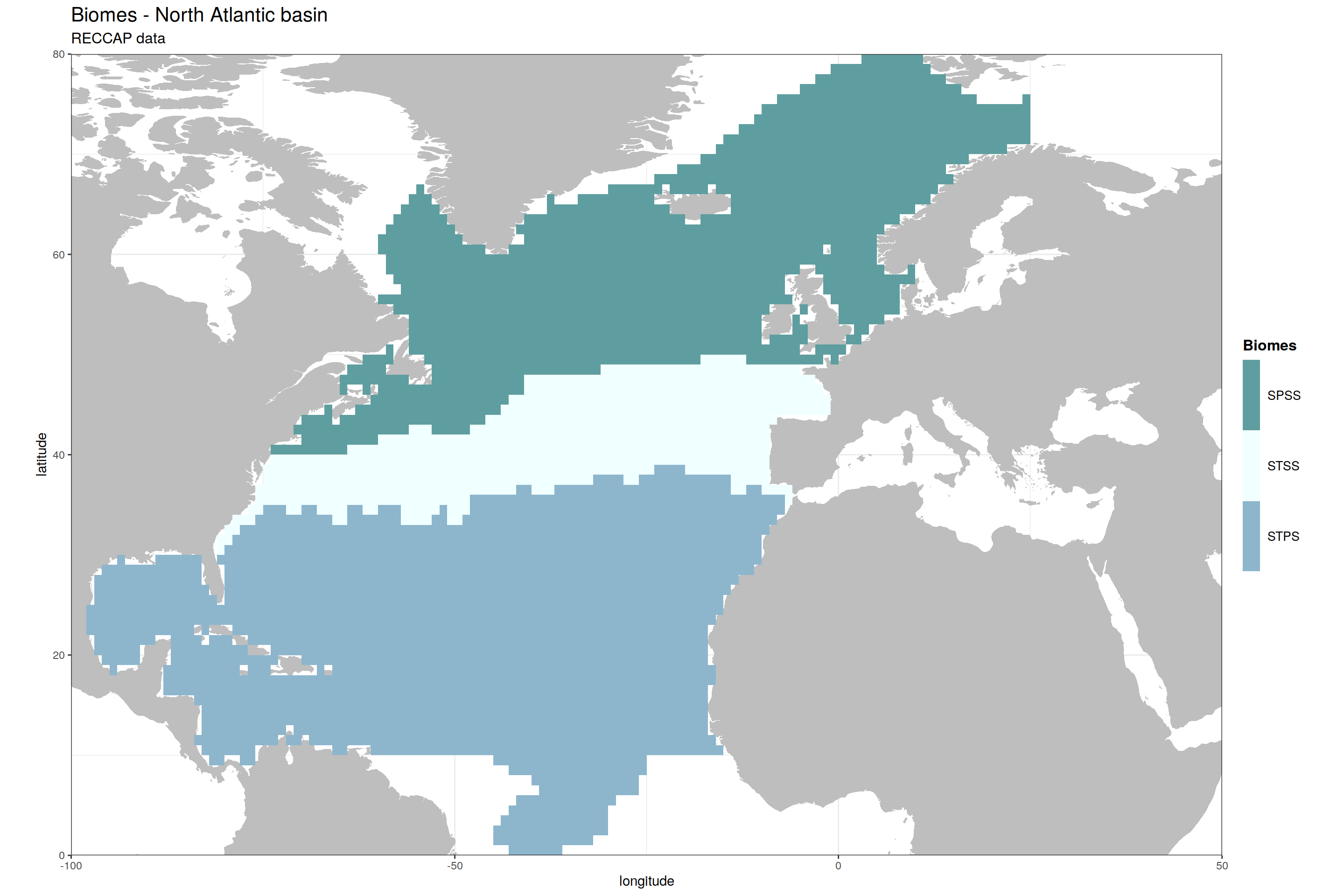
| Version | Author | Date |
|---|---|---|
| cc29085 | mlarriere | 2024-06-06 |
Load Argo floats data
Load SST anomaly
#Read SST anomaly, computed using climatology:2009-2019 (from anomaly_SST_2023.Rmd)
sst_anomaly_northAtlantic<- read_rds(paste(path_argo_core_preprocessed, "/SST_anomaly2023_NorthAtlantic_clim2004-2019.rds", sep = ""))Argo floats
Distribution over North Atlantic basin
#Histogram -- number of floats per month and biome
unique_platforms_per_month <- core_anomaly_with_platform_2023 %>%
group_by(month) %>%
filter(lat>0, lat<70, lon>-80, lon<0) %>%
summarize(unique_platforms = n_distinct(platform_number))
ggplot(unique_platforms_per_month, aes(x = factor(month), y = unique_platforms)) +
geom_bar(stat = "identity", fill = "lightskyblue3",color = "black", size = 0.25) +
labs(title = "Amount of platform per month, in North Atlantic, 2023",
x = "Months", y = "Number of argo floats", fill = "Biomes") +
theme_minimal() +
guides(fill = FALSE)
| Version | Author | Date |
|---|---|---|
| 5601558 | mlarriere | 2024-06-13 |
# scale_fill_manual(values = c("1" = "#1034A6", "2" = "#f59c04", "3" = "darkred"), labels = c("1" = "SPSS", "2" = "STSS", "3" = "STPS")) +
#Number of cycle per platform
cycle_counts <- core_anomaly_with_platform_2023 %>%
group_by(platform_number) %>%
summarise(cycle_count = n_distinct(cycle_number))#Join the SST anomaly with the core Argo anomaly profiles
core_anomaly_with_platform_2023<-core_anomaly_with_platform_2023 %>%
filter(!is.na(depth)) %>%
select(-profile_range)
complete_anomaly_profile<- core_anomaly_with_platform_2023 %>%
inner_join(sst_anomaly_northAtlantic, by = c("lat", "lon", "month"))
#---Chosen subset
core_anomaly_2023_natlantic_subset<- complete_anomaly_profile %>%
filter(lat > chosen_extent$lat_min, lat < chosen_extent$lat_max,
lon > chosen_extent$lon_min, lon < chosen_extent$lon_max) %>%
select(-interpolated_temp) #Number of platform present in each lat/lon location per month
float_monthly_count <- core_anomaly_with_platform_2023 %>%
group_by(lon, lat) %>%
summarise(months_present = n_distinct(month)) %>%
ungroup()
#Mean SST anomaly over 2023
HadISST_anomaly_mean2023 <- sst_anomaly_northAtlantic %>%
group_by(lon, lat) %>%
summarise(yearly_SSTanomaly= mean(SST_anomaly, na.rm = TRUE)) %>%
ungroup()
#Plots
SST_2023_plot <- ggplot()+
geom_raster(data=HadISST_anomaly_mean2023, aes(lon, lat, fill = yearly_SSTanomaly)) +
geom_map(data = world_coordinates, map = world_coordinates, aes(long, lat, map_id = region), fill = "grey") +
lims(x = c(chosen_extent$lon_min, chosen_extent$lon_max), y=c(chosen_extent$lat_min, chosen_extent$lat_max)) +
scale_fill_viridis_c(option = "magma", limits = c(0, 1.5)) +
labs(title = "SST anomaly, annual average 2023",
subtitle = "Resolution: 1°x1°",
x='Longitude', y='Latitude',
fill = "SST \nanomalies [°C]")+
coord_quickmap(expand = 0)+
theme(plot.title = element_text(size = 18),
plot.subtitle = element_text(size = 16),
legend.title = element_text(size = 14),
legend.text = element_text(size = 12),
axis.title.x = element_text(size = 12),
axis.title.y = element_text(size = 12),
axis.text.x = element_text(size = 12),
axis.text.y = element_text(size = 12),
legend.key.width = unit(0.3, "cm"),
legend.key.height = unit(2, "cm")
)
float_distrib <- ggplot() +
geom_point(data = float_monthly_count, aes(x = lon, y = lat, color = months_present)) +
geom_map(data = world_coordinates, map = world_coordinates, aes(long, lat, map_id = region), fill = "grey") +
lims(x = c(chosen_extent$lon_min, chosen_extent$lon_max), y=c(chosen_extent$lat_min, chosen_extent$lat_max)) +
labs(title = "Platform Locations",
subtitle = "Resolution: 1°x1°",
x='Longitude', y='Latitude',
color = "Months \nwith float") +
scale_color_scico(palette = "oslo", breaks = seq(1, 12, by = 1), limits = c(1, 12), direction=-1) +
coord_quickmap(expand = 0) +
theme(plot.title = element_text(size = 18),
plot.subtitle = element_text(size = 16),
legend.title = element_text(size = 14),
legend.text = element_text(size = 12),
axis.title.x = element_text(size = 12),
axis.title.y = element_text(size = 12),
axis.text.x = element_text(size = 12),
axis.text.y = element_text(size = 12),
legend.key.width = unit(0.3, "cm"),
legend.key.height = unit(2, "cm")
)
#combining the SST anomalies plot and Float distrib
combined_plot <- SST_2023_plot + float_distrib + plot_layout(ncol = 2)
combined_plot
Distribution over East-North Atlantic
Using the SST map computed in “anomaly_SST_2023.Rmd” and ClimateReanalyser, we identify one area of particular interest for SST anomalies in 2023 in the North Atlantic Ocean: The East coast of the North Atlantic Ocean, where the SST anomalies are high on an annual basis, with a sharp increase from June onwards.
#Number of platform present per month in the chosen area
platform_counts <- aggregate(platform_number ~ month, data = core_anomaly_2023_natlantic_subset, FUN = function(x) length(unique(x)))
#Number of cycle present per month and per platform in the chosen area
cycle_count_per_platform_month <- core_anomaly_2023_natlantic_subset %>%
group_by(month, platform_number) %>%
summarise(cycle_count = n_distinct(cycle_number))
#---Plot the platform present in the region of interest for each month
custom_labeller <- function(variable, value) {
month_count <- platform_counts[platform_counts$month == value, "platform_number"]
return(paste("Month:", value, "\nNumber of floats:", month_count))
}
sst_anomaly_northAtlantic_subset<-sst_anomaly_northAtlantic %>%
filter(lat > chosen_extent$lat_min, lat < chosen_extent$lat_max,
lon > chosen_extent$lon_min, lon < chosen_extent$lon_max)
ggplot() +
geom_tile(data=sst_anomaly_northAtlantic_subset, aes(x = lon, y = lat, fill = SST_anomaly)) + #tile with SST
geom_point(data = core_anomaly_2023_natlantic_subset, aes(x = lon, y = lat), color = "lightblue") + # Point for float position
geom_map(data = world_coordinates, map = world_coordinates, aes(long, lat, map_id = region), fill = "grey") + #base map
lims(x = c(chosen_extent$lon_min, chosen_extent$lon_max), y=c(chosen_extent$lat_min, chosen_extent$lat_max)) +
coord_quickmap(expand = 0) +
scale_fill_viridis_c(option = "plasma") +
labs(title = "Platform Locations",
subtitle = "Resolution: 1°x1°, SST from SOM",
color = "Months with float") +
theme(plot.title = element_text(size = 18),
plot.subtitle = element_text(size = 16),
legend.title = element_text(size = 14),
legend.text = element_text(size = 12),
axis.title.x = element_text(size = 12),
axis.title.y = element_text(size = 12),
axis.text.x = element_text(size = 12),
axis.text.y = element_text(size = 12),
legend.key.width = unit(0.3, "cm"),
legend.key.height = unit(2, "cm")
)+
facet_wrap(~month, ncol = 3, labeller = custom_labeller)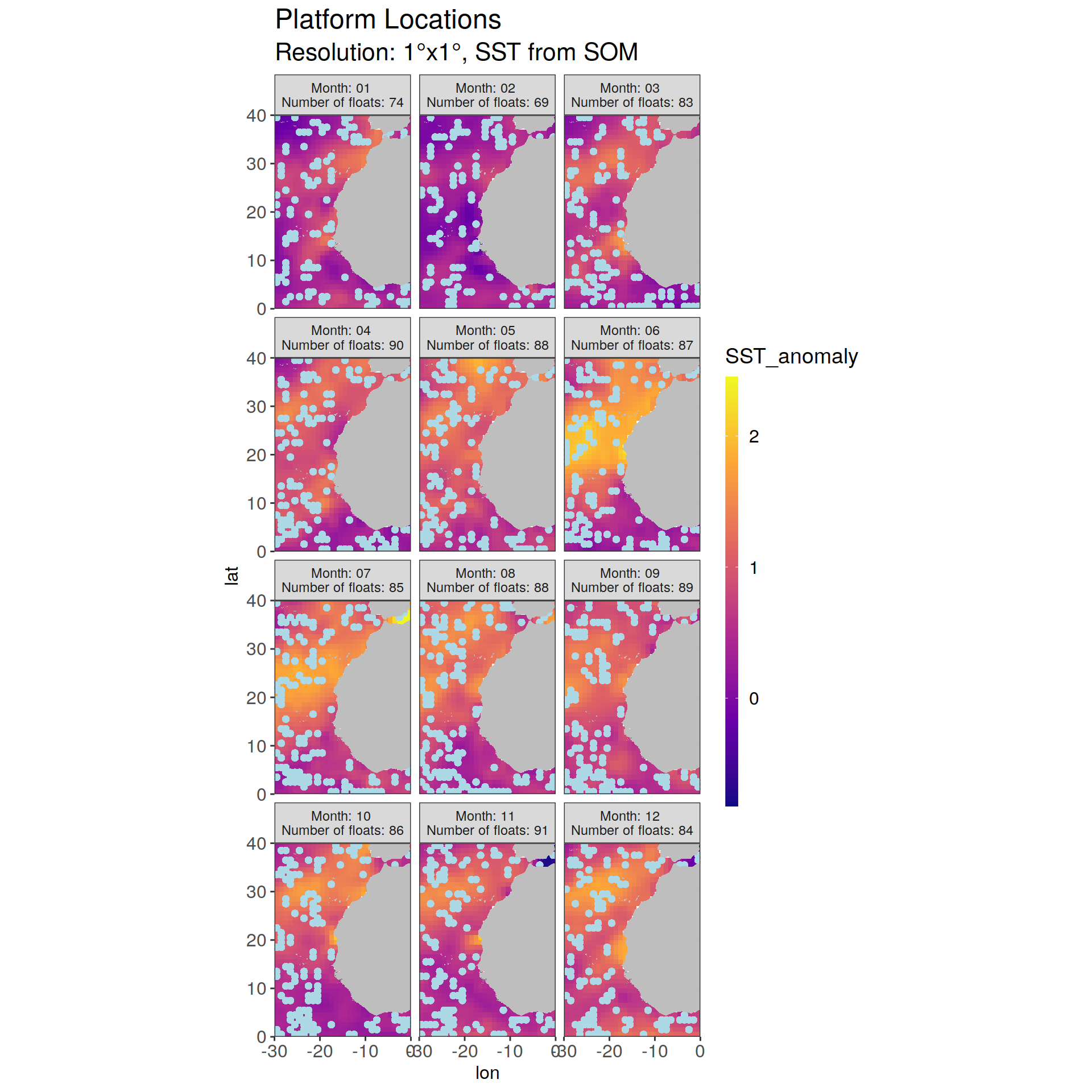
Anomaly profiles
Individual float
Inspection of single floats to understand the physical processes impacting the argo floats measurements - Float chosen is located in the Eddies Corridor (Canary Islands)
#Choosing 1 float
unique_platform<-core_anomaly_2023_natlantic_subset %>%
filter(platform_number==1902323) #in the eddies corridor
ggplot() +
geom_path(data=unique_platform, aes(x = anomaly, y = depth, color = factor(month), group = cycle_number)) +
geom_vline(xintercept = 0) +
scale_y_reverse() +
coord_cartesian(xlim = c(-6, 6), ylim = c(200, 0)) +
scale_color_manual(values = colorRampPalette(c("#2796A5", "#F3712B", "#880D1E"))(12)) +
labs(title = 'SST anomalies propagation \nof a single float',
subtitle = 'Location: Canaries Islands (Eddies corridor)',
x = 'Temperature (°C)', y = 'Depth (m)', color = 'Months') +
theme(plot.title = element_text(size = 18),
plot.subtitle = element_text(size = 16),
legend.text = element_text(size = 12),
legend.title = element_text(size = 14, face = "bold")
)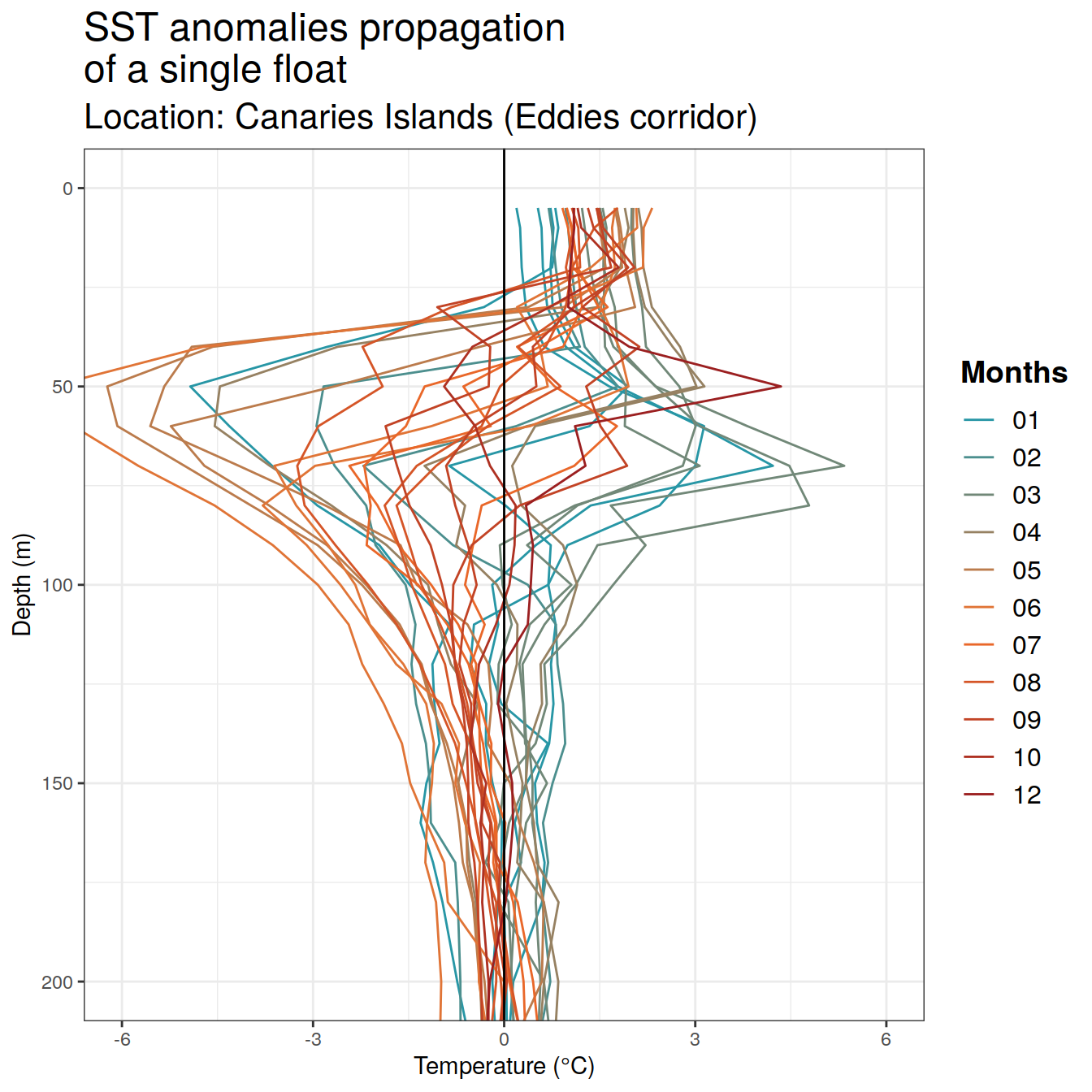
Coloring by lat/lon
Inspection of the potential spatial gradient that may influence the SST anomalies penetration: longitude and latitude gradients.
#Calculating monthly mean anomaly for each lat/lon pair of the area
anomaly_lat_lon <- core_anomaly_2023_natlantic_subset %>%
group_by(lat, lon, depth, month, platform_number, cycle_number) %>%
summarise(temp_anomaly_mean = mean(anomaly, na.rm = TRUE))
# Longitude - gradient west-east
longitude<- ggplot(anomaly_lat_lon, aes(x = temp_anomaly_mean, y = depth,
group = interaction(platform_number, cycle_number),
color = as.numeric(lon))) +
geom_path() +
geom_vline(xintercept = 0) +
scale_y_reverse(limits = c(200, 0)) +
coord_cartesian(xlim = c(-6, 6)) +
facet_wrap(~ month, ncol = 3) +
labs( x = 'Temperature anomaly [°C]', y = 'Depth [m]', color = "Longitude") +
scale_color_viridis_c()+
theme(plot.title = element_text(size = 18),
plot.subtitle = element_text(size = 16),
axis.title.x = element_text(size = 12),
axis.title.y = element_text(size = 14),
axis.text.x = element_text(size = 12),
axis.text.y = element_text(size = 14),
legend.text = element_text(size = 12),
legend.title = element_text(size = 14, face = "bold"),
legend.key.width = unit(0.3, "cm"),
legend.key.height = unit(1, "cm"))
# Latitude - gradient north-south
latitude<- ggplot(anomaly_lat_lon, aes(x = temp_anomaly_mean, y = depth,
group = interaction(platform_number, cycle_number),
color = as.numeric(lat))) +
geom_path() +
geom_vline(xintercept = 0) +
scale_y_reverse(limits = c(200, 0)) +
coord_cartesian(xlim = c(-6, 6)) +
facet_wrap(~ month, ncol = 3) +
labs( x = 'Temperature anomaly [°C]', y = 'Depth [m]', color = "Latitude") +
scale_color_viridis_c()+
theme(plot.title = element_text(size = 18),
plot.subtitle = element_text(size = 16),
axis.title.x = element_text(size = 12),
axis.title.y = element_text(size = 14),
axis.text.x = element_text(size = 12),
axis.text.y = element_text(size = 14),
legend.text = element_text(size = 12),
legend.title = element_text(size = 14, face = "bold"),
legend.key.width = unit(0.3, "cm"),
legend.key.height = unit(1, "cm"))
combined_plot <- latitude + longitude + plot_layout(ncol = 1)+
plot_annotation(title = 'Latitude and longitude gradients',
subtitle = "All floats and cycles included",
theme = theme(plot.title = element_text(size = 18),
plot.subtitle = element_text(size = 16))
)
combined_plot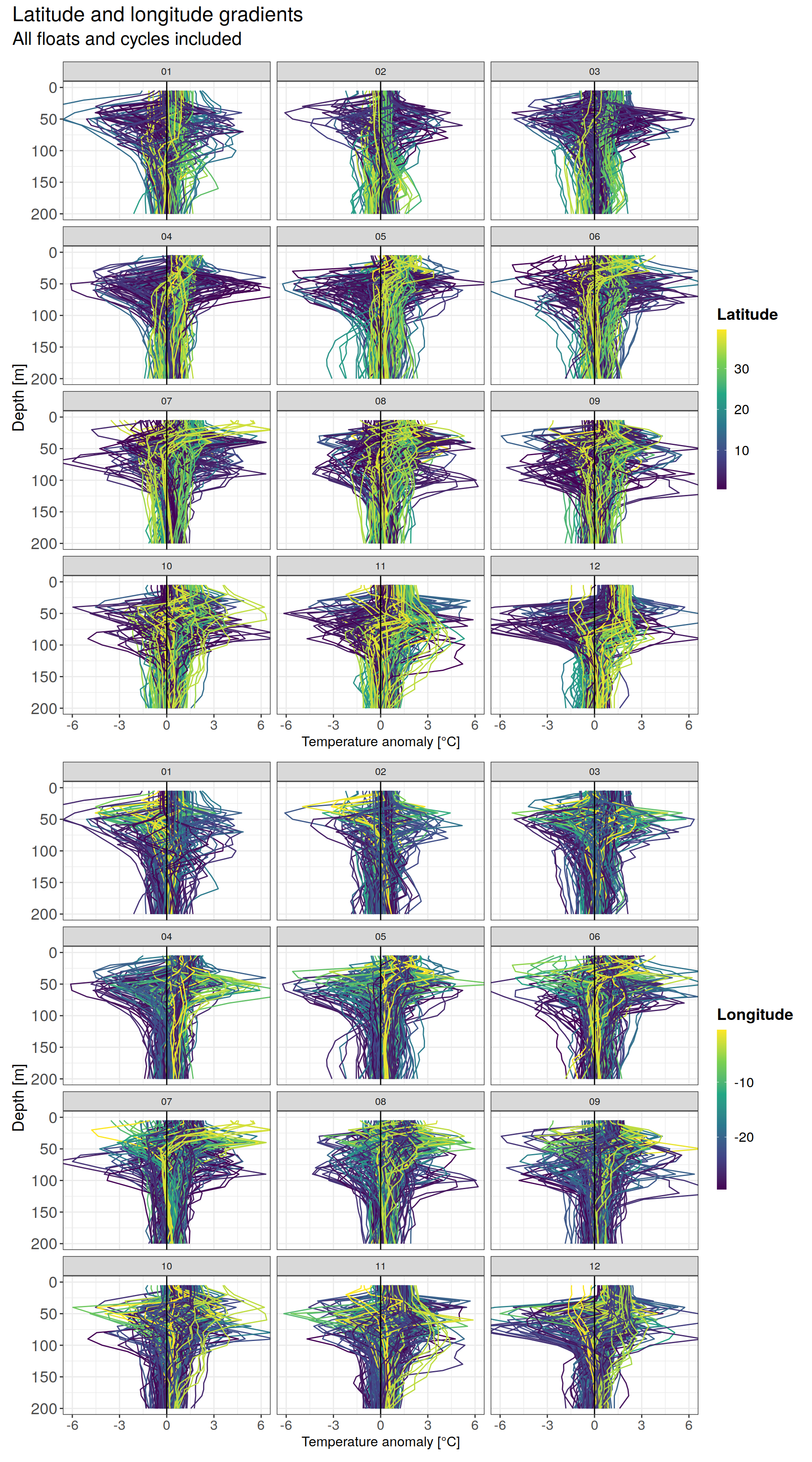
Coloring by SST anomaly
Looking at the SST anomalies that may influence the vertical structure of the MHS penetration
#Calculating monthly mean anomaly as function of SST anomaly for each Argo cycle
anomaly_summary <- core_anomaly_2023_natlantic_subset %>%
group_by(platform_number, depth, month, cycle_number, SST_anomaly) %>%
summarise(temp_anomaly_mean = mean(anomaly, na.rm = TRUE))
#plot
ggplot(anomaly_summary, aes(x = temp_anomaly_mean, y = depth, group = interaction(platform_number, cycle_number), color = as.numeric(SST_anomaly))) +
geom_path() +
geom_vline(xintercept = 0) +
scale_y_reverse(limits = c(200, 0)) +
coord_cartesian(xlim = c(-6, 6)) +
facet_wrap(~ month, ncol = 3) +
labs(title = "Mean Anomaly Profile as a function of SST anomaly",
x = "Temperature (°C)", y = "Depth (m)", color = "SST Anomaly") +
scale_color_viridis_c()+
theme(plot.title = element_text(size = 18),
plot.subtitle = element_text(size = 16),
axis.title.x = element_text(size = 12),
axis.title.y = element_text(size = 14),
axis.text.x = element_text(size = 12),
axis.text.y = element_text(size = 14),
legend.text = element_text(size = 12),
strip.text = element_text(size = 14),
legend.title = element_text(size = 14, face = "bold"),
legend.key.width = unit(0.3, "cm"),
legend.key.height = unit(1, "cm"))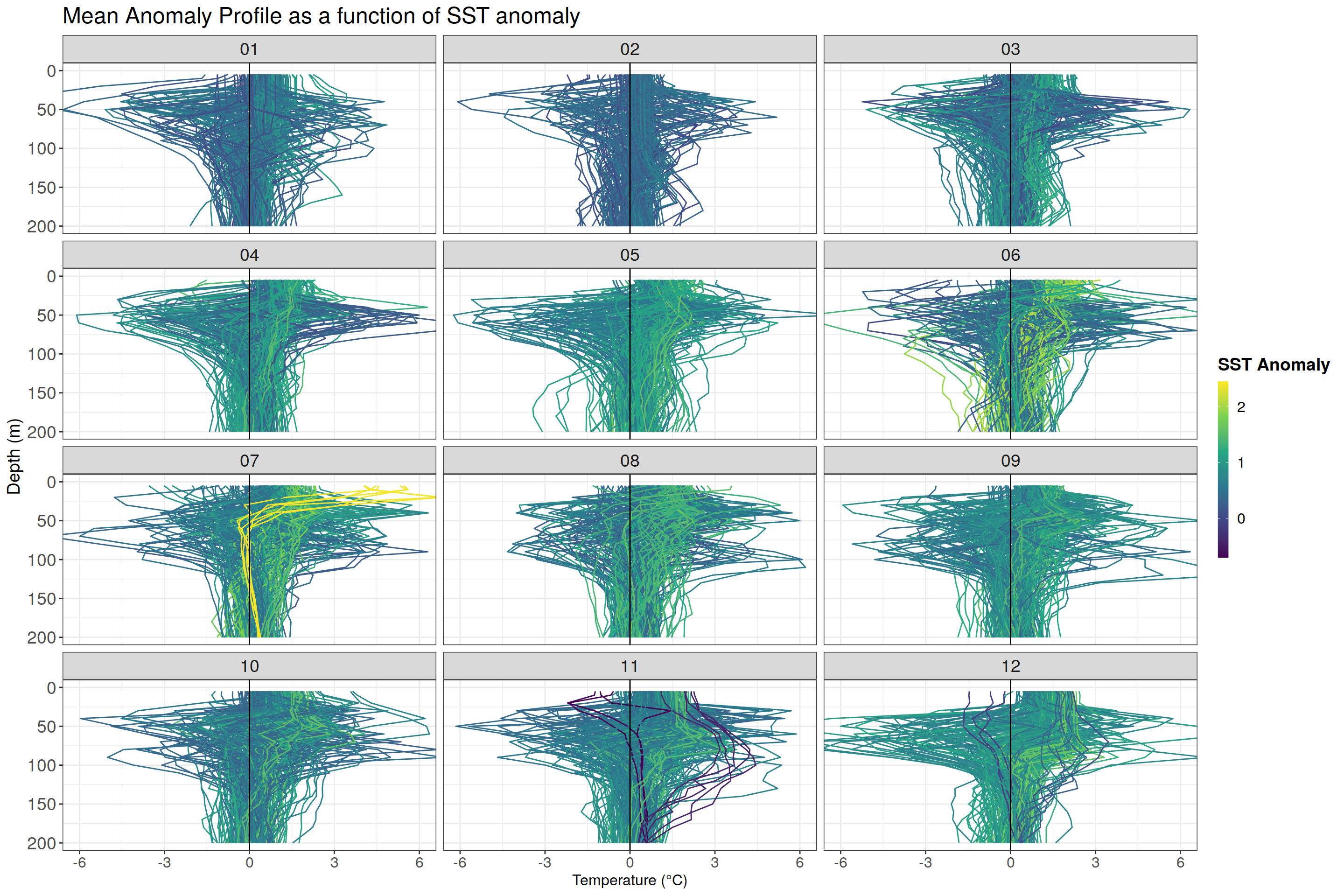
Coloring by day within a month
#Calculating monthly mean anomaly as function of day within the month for each Argo cycle
anomaly_summary_day <- core_anomaly_2023_natlantic_subset %>%
group_by(platform_number, depth, month, cycle_number, day) %>%
summarise(temp_anomaly_mean = mean(anomaly, na.rm = TRUE))
#plot for time during month
ggplot(anomaly_summary_day, aes(x = temp_anomaly_mean, y = depth, group = interaction(platform_number, cycle_number), color = as.numeric(day))) +
geom_path() +
geom_vline(xintercept = 0) +
scale_y_reverse(limits = c(200, 0)) +
coord_cartesian(xlim = c(-6, 6)) +
facet_wrap(~ month, ncol = 3) +
labs(title = "Mean Anomaly Profile as function of time",
x = "Temperature (°C)", y = "Depth (m)", color = "day within \nthe month") +
scale_color_viridis_c()+
theme(plot.title = element_text(size = 18),
plot.subtitle = element_text(size = 16),
axis.title.x = element_text(size = 12),
axis.title.y = element_text(size = 14),
axis.text.x = element_text(size = 12),
axis.text.y = element_text(size = 14),
legend.text = element_text(size = 12),
strip.text = element_text(size = 14),
legend.title = element_text(size = 14, face = "bold"),
legend.key.width = unit(0.3, "cm"),
legend.key.height = unit(1, "cm"))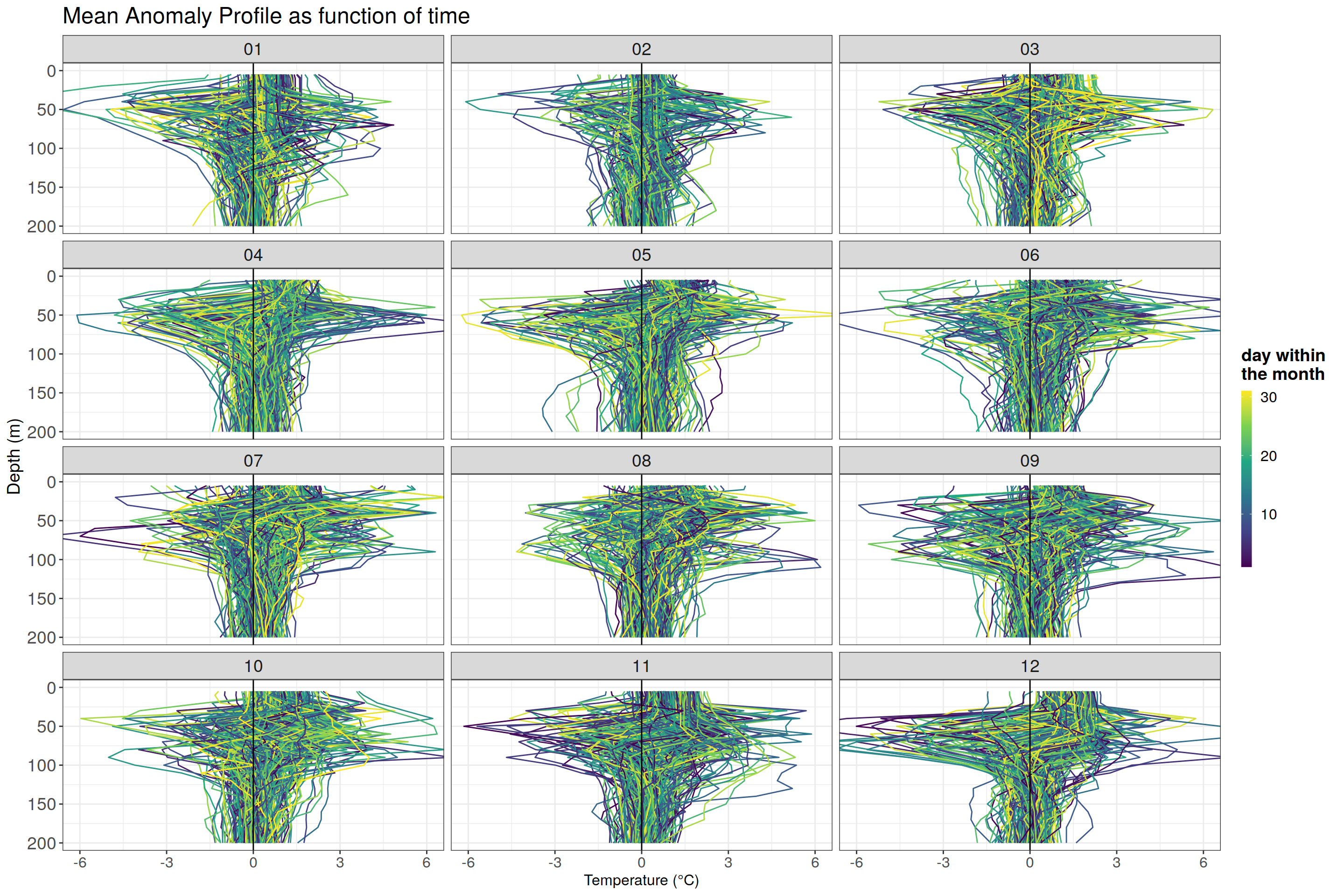
Monthly anomaly profiles
# Dataset with the cycle number per float across months
cycles_per_platform_month<- core_anomaly_2023_natlantic_subset %>%
group_by(platform_number, month) %>%
summarize(unique_cycles = toString(unique(cycle_number)))
# Calculating monthly mean anomaly + std dev over the east area by averaging the anomaly of each float present
anomaly_mean <- core_anomaly_2023_natlantic_subset %>%
group_by(depth, month) %>%
summarise(temp_anomaly_mean = mean(anomaly, na.rm = TRUE),
temp_anomaly_sd = sd(anomaly, na.rm = TRUE))
#For each month: the SST anomaly and vertical anomaly profile plots next to each other
for (m in unique(core_anomaly_2023_natlantic_subset$month)) {
# Filter data
map_data <- filter(sst_anomaly_northAtlantic_subset, month == m)
anomaly_data <- filter(anomaly_mean, month == m)
# Plot for temperature anomaly map from HadISST dataset
map_plot <- ggplot() +
geom_tile(data=map_data, aes(x = lon, y = lat, fill = SST_anomaly)) +
geom_map(data = world_coordinates, map = world_coordinates, aes(long, lat, map_id = region), fill = "grey") + #base map
lims(x = c(chosen_extent$lon_min, chosen_extent$lon_max), y=c(chosen_extent$lat_min, chosen_extent$lat_max)) +
coord_quickmap(expand = 0) +
scale_fill_viridis_c(option = "plasma") +
labs(title = paste("SST Anomaly (°C) in North Atlantic - 2023", month.name[as.numeric(m)]),
subtitle = paste0("Extent: ", name_extent),
x = "Longitude", y = "Latitude") +
theme(legend.position = 'right', legend.key.height = unit(2, "cm"),
plot.title = element_text(size = 18),
plot.subtitle = element_text(size = 16),
legend.text = element_text(size = 13),
legend.title = element_text(size = 15, face = "bold")
)
# Plot for anomaly profiles
anomaly_plot <- ggplot(anomaly_data, aes(x = temp_anomaly_mean, y = depth, color = factor(month))) +
geom_path() +
geom_ribbon(aes(xmax = temp_anomaly_mean + temp_anomaly_sd,
xmin = temp_anomaly_mean - temp_anomaly_sd,
y = depth), alpha = 0.2) +
geom_vline(xintercept = 0) +
scale_y_reverse() +
coord_cartesian(xlim = c(-4, 4), ylim = c(200, 0)) +
labs(title = paste('Associated anomaly profile in', month.name[as.numeric(m)]),
subtitle = paste0("from surface to 200m", "\nNumber of platform:", nrow(filter(cycles_per_platform_month, month==m))),
x = 'Temperature (°C)', y = 'Depth (m)') +
theme_minimal()+
guides(color = FALSE)+
theme(legend.position = 'right', legend.key.height = unit(2, "cm"),
plot.title = element_text(size = 18),
plot.subtitle = element_text(size = 16),
legend.text = element_text(size = 13),
legend.title = element_text(size = 15, face = "bold")
)
#plots side by side
combined_plot <- grid.arrange(map_plot, anomaly_plot, ncol = 2)
print(combined_plot)
}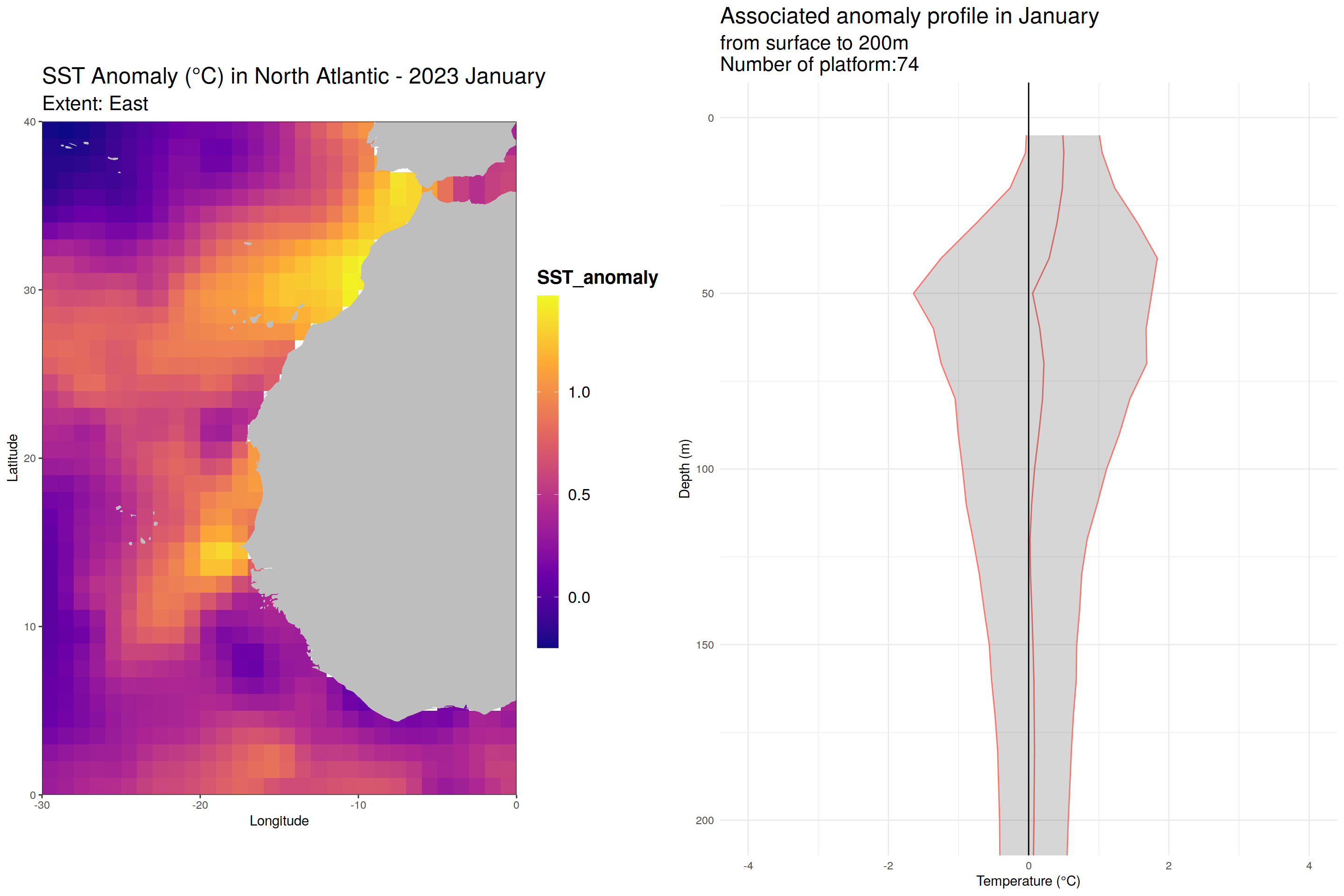
TableGrob (1 x 2) "arrange": 2 grobs
z cells name grob
1 1 (1-1,1-1) arrange gtable[layout]
2 2 (1-1,2-2) arrange gtable[layout]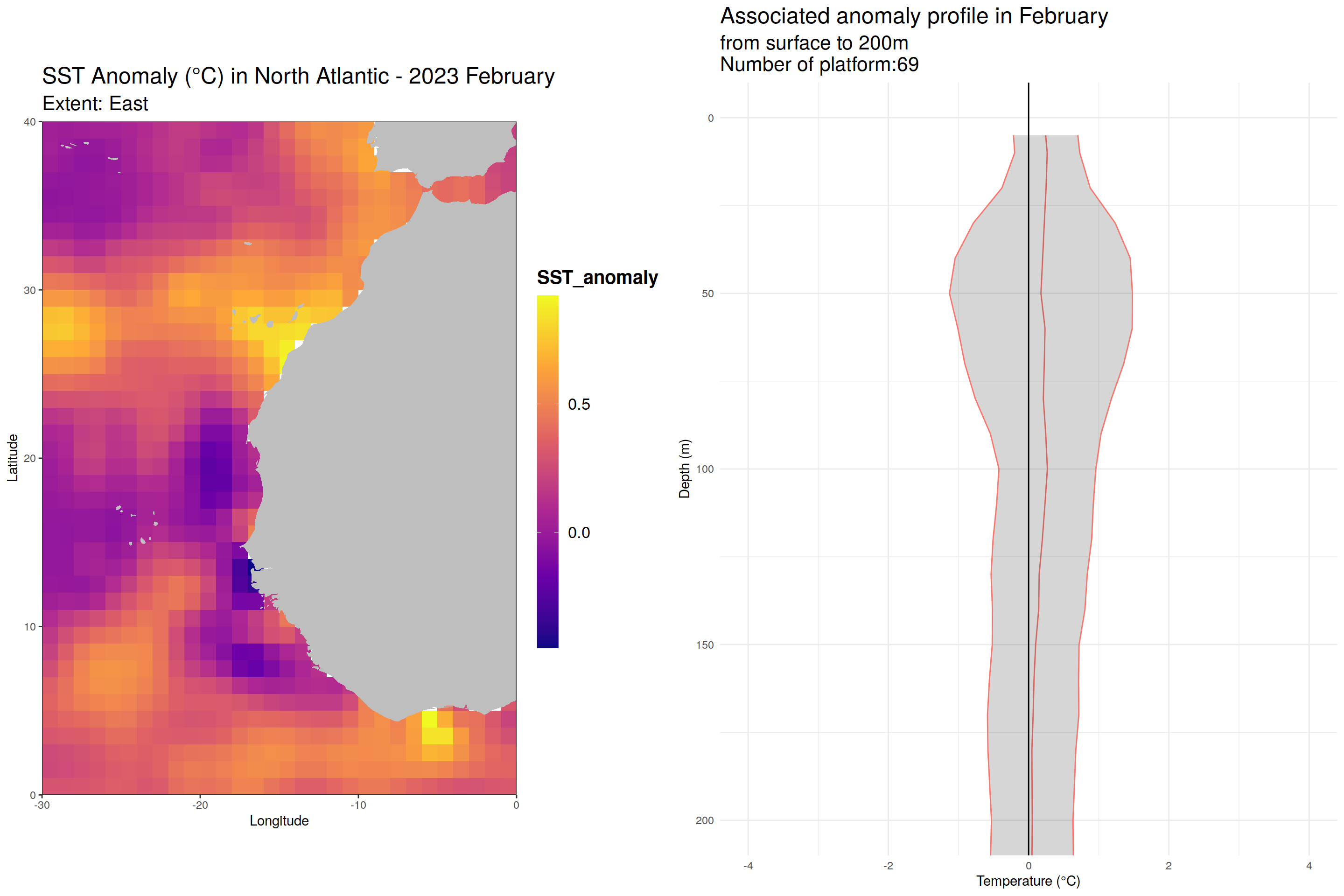
TableGrob (1 x 2) "arrange": 2 grobs
z cells name grob
1 1 (1-1,1-1) arrange gtable[layout]
2 2 (1-1,2-2) arrange gtable[layout]
TableGrob (1 x 2) "arrange": 2 grobs
z cells name grob
1 1 (1-1,1-1) arrange gtable[layout]
2 2 (1-1,2-2) arrange gtable[layout]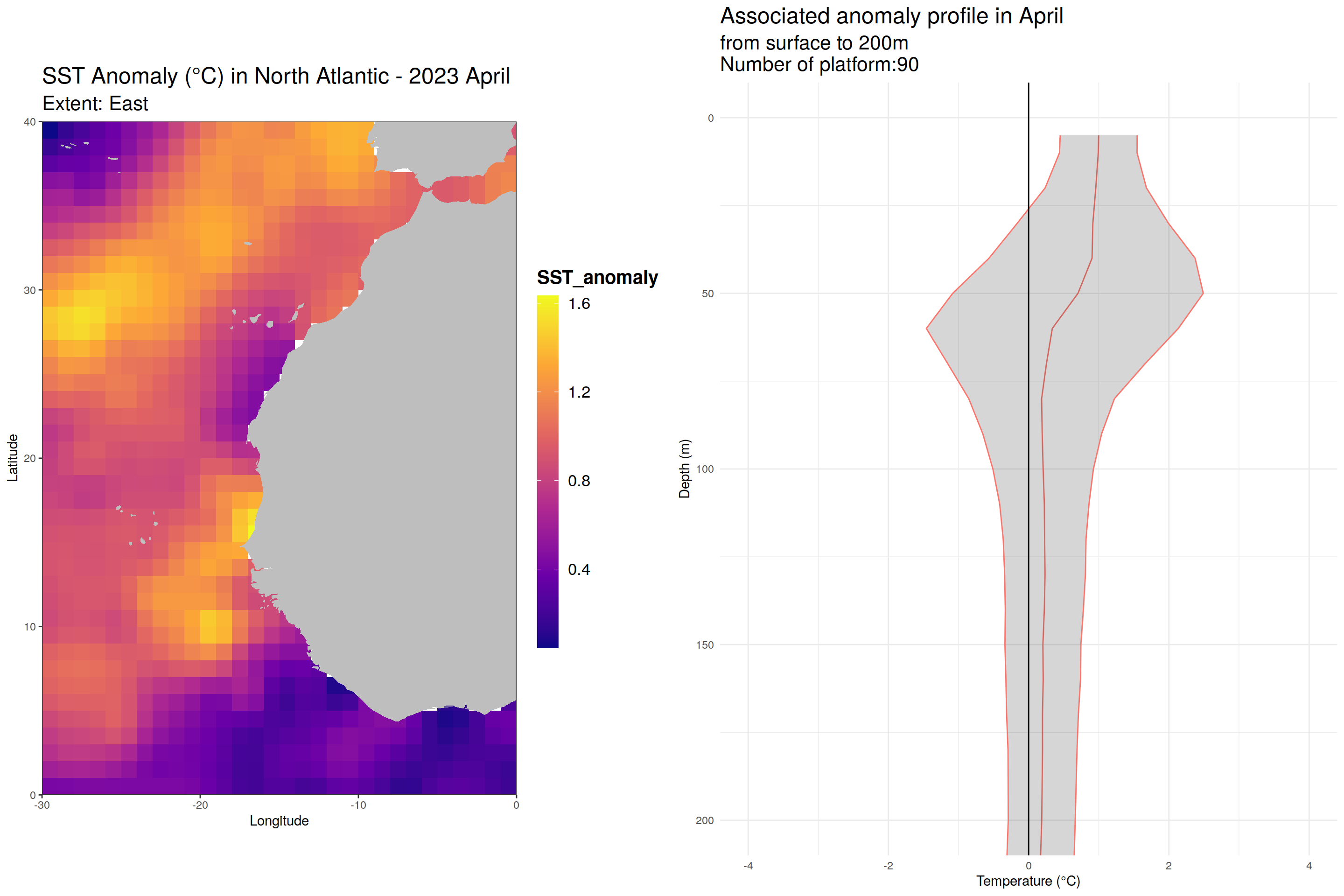
TableGrob (1 x 2) "arrange": 2 grobs
z cells name grob
1 1 (1-1,1-1) arrange gtable[layout]
2 2 (1-1,2-2) arrange gtable[layout]
TableGrob (1 x 2) "arrange": 2 grobs
z cells name grob
1 1 (1-1,1-1) arrange gtable[layout]
2 2 (1-1,2-2) arrange gtable[layout]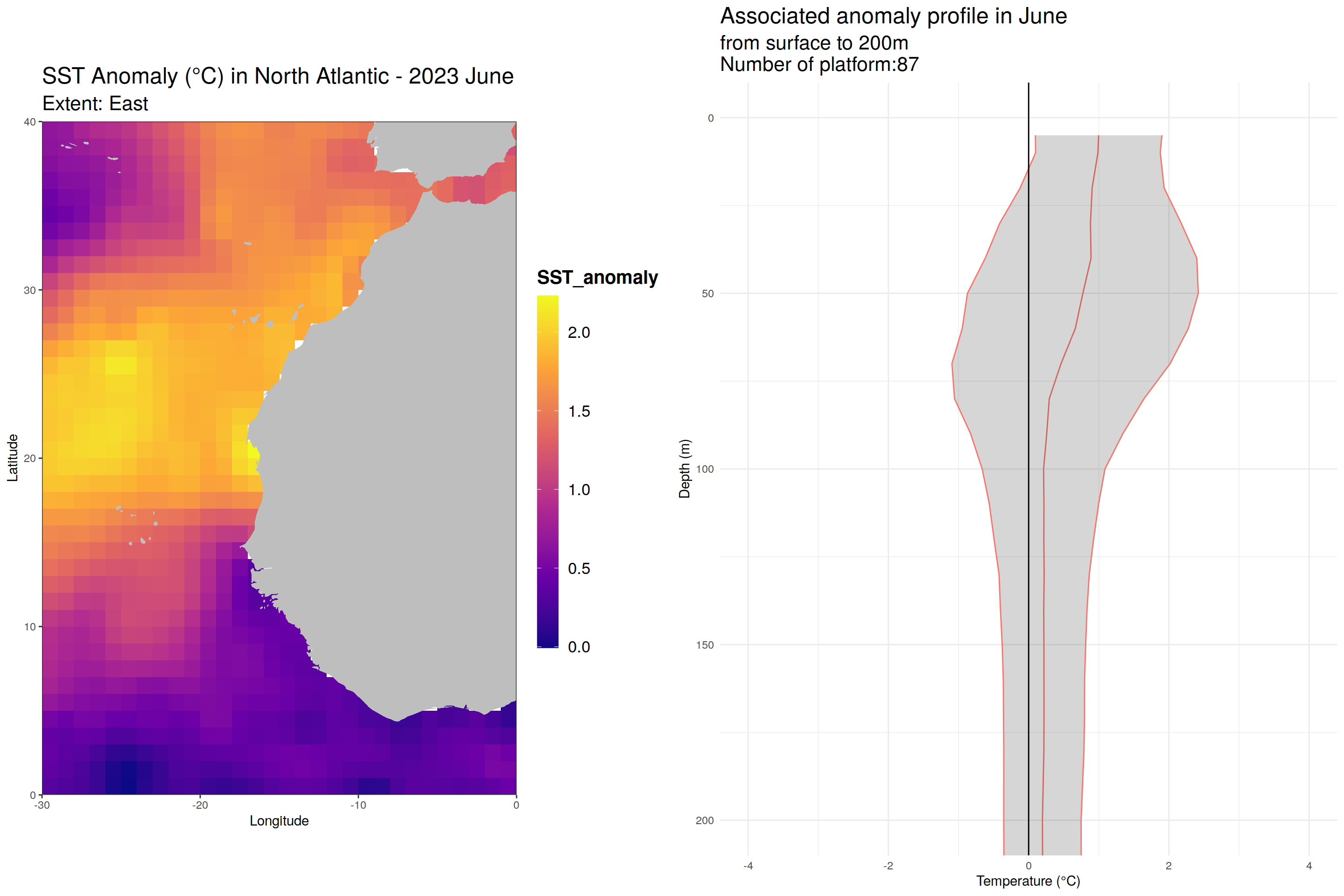
TableGrob (1 x 2) "arrange": 2 grobs
z cells name grob
1 1 (1-1,1-1) arrange gtable[layout]
2 2 (1-1,2-2) arrange gtable[layout]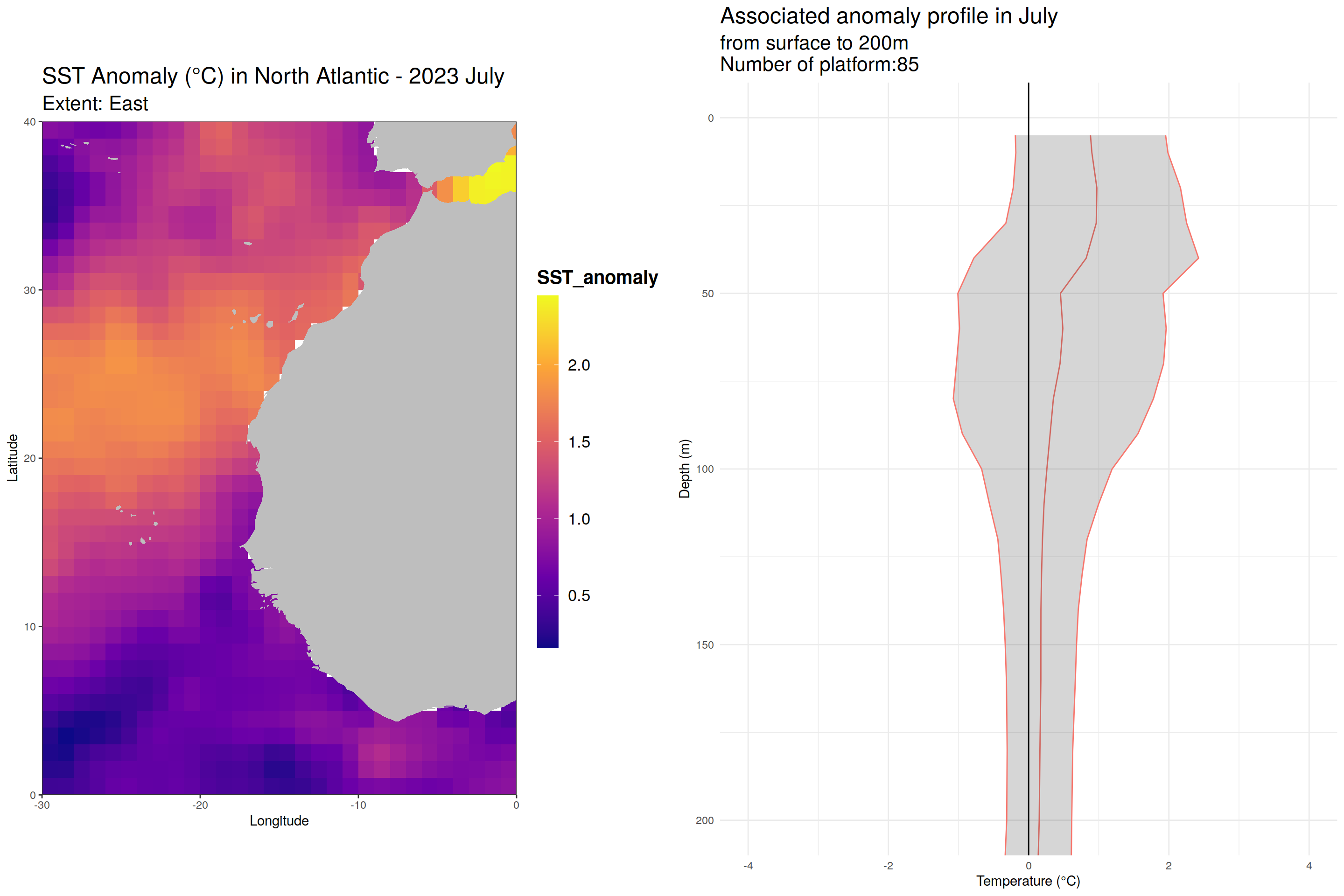
TableGrob (1 x 2) "arrange": 2 grobs
z cells name grob
1 1 (1-1,1-1) arrange gtable[layout]
2 2 (1-1,2-2) arrange gtable[layout]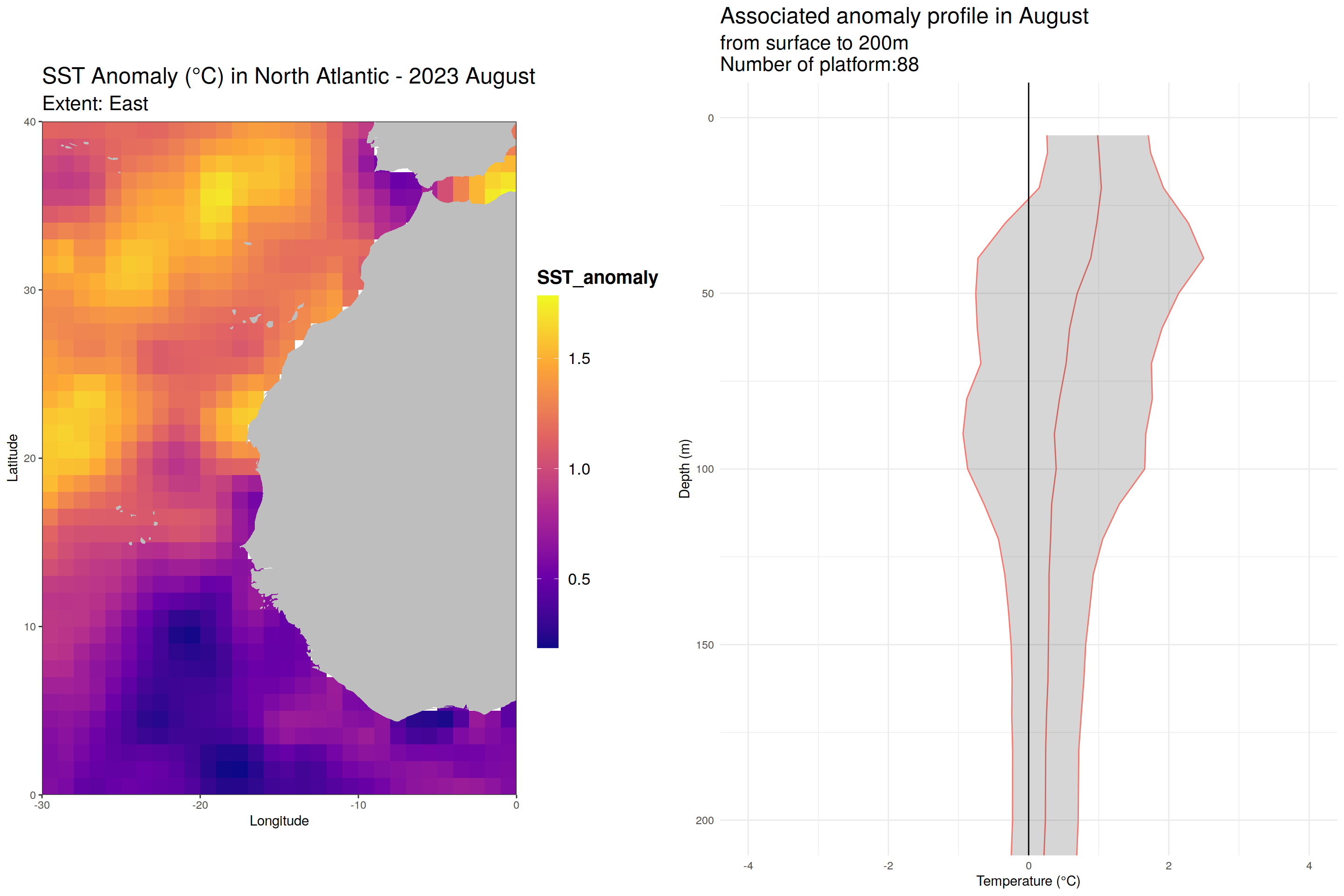
TableGrob (1 x 2) "arrange": 2 grobs
z cells name grob
1 1 (1-1,1-1) arrange gtable[layout]
2 2 (1-1,2-2) arrange gtable[layout]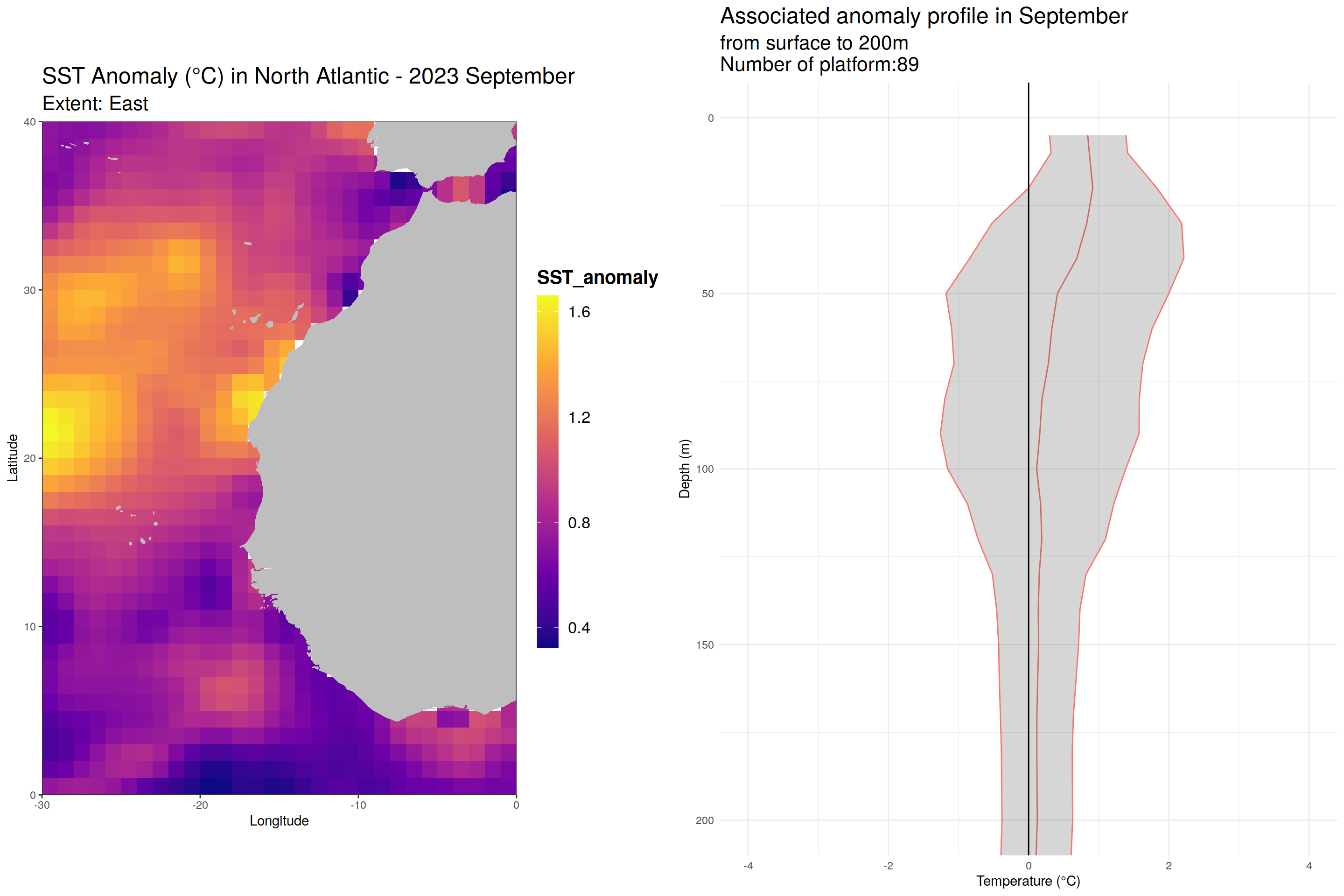
TableGrob (1 x 2) "arrange": 2 grobs
z cells name grob
1 1 (1-1,1-1) arrange gtable[layout]
2 2 (1-1,2-2) arrange gtable[layout]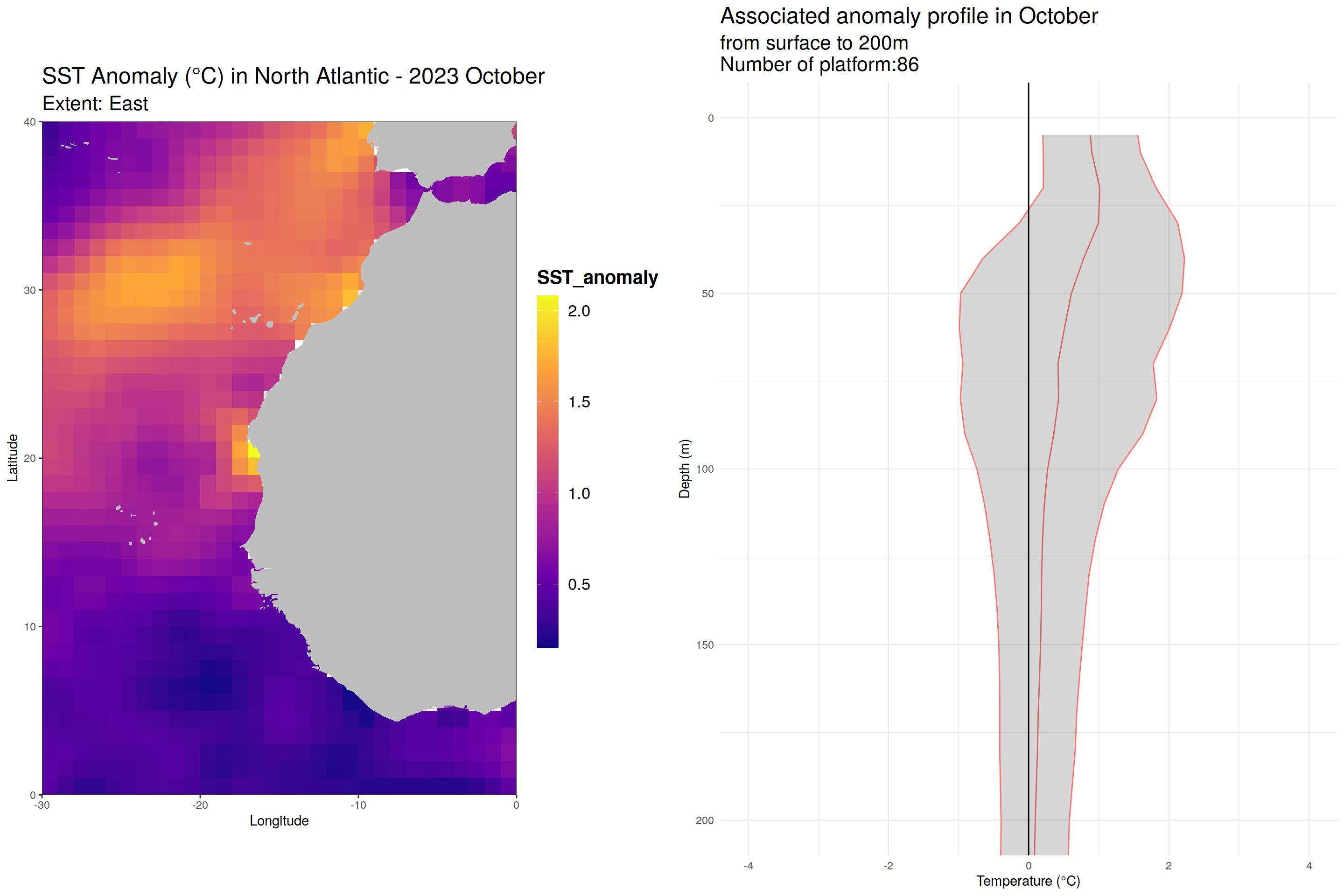
TableGrob (1 x 2) "arrange": 2 grobs
z cells name grob
1 1 (1-1,1-1) arrange gtable[layout]
2 2 (1-1,2-2) arrange gtable[layout]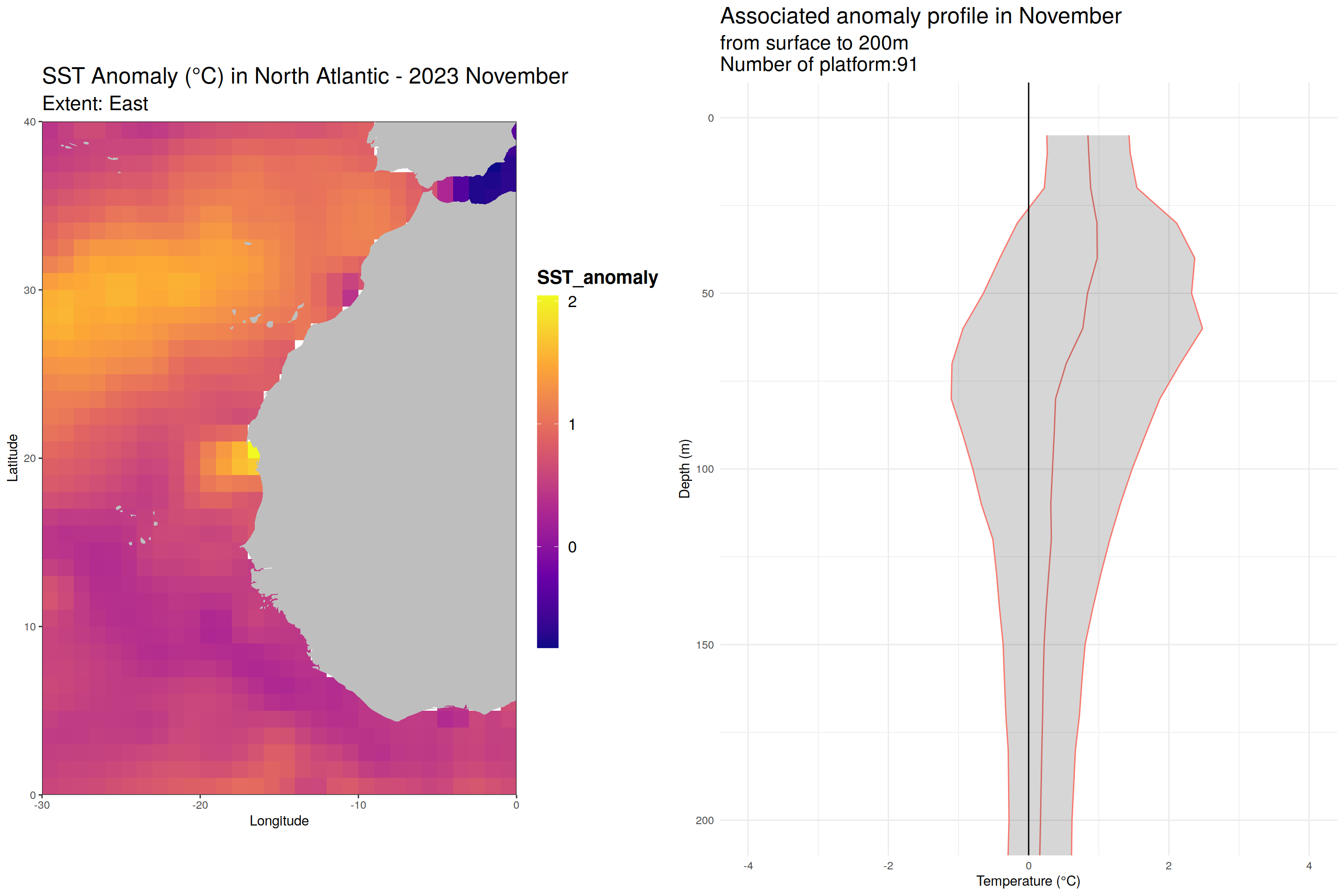
TableGrob (1 x 2) "arrange": 2 grobs
z cells name grob
1 1 (1-1,1-1) arrange gtable[layout]
2 2 (1-1,2-2) arrange gtable[layout]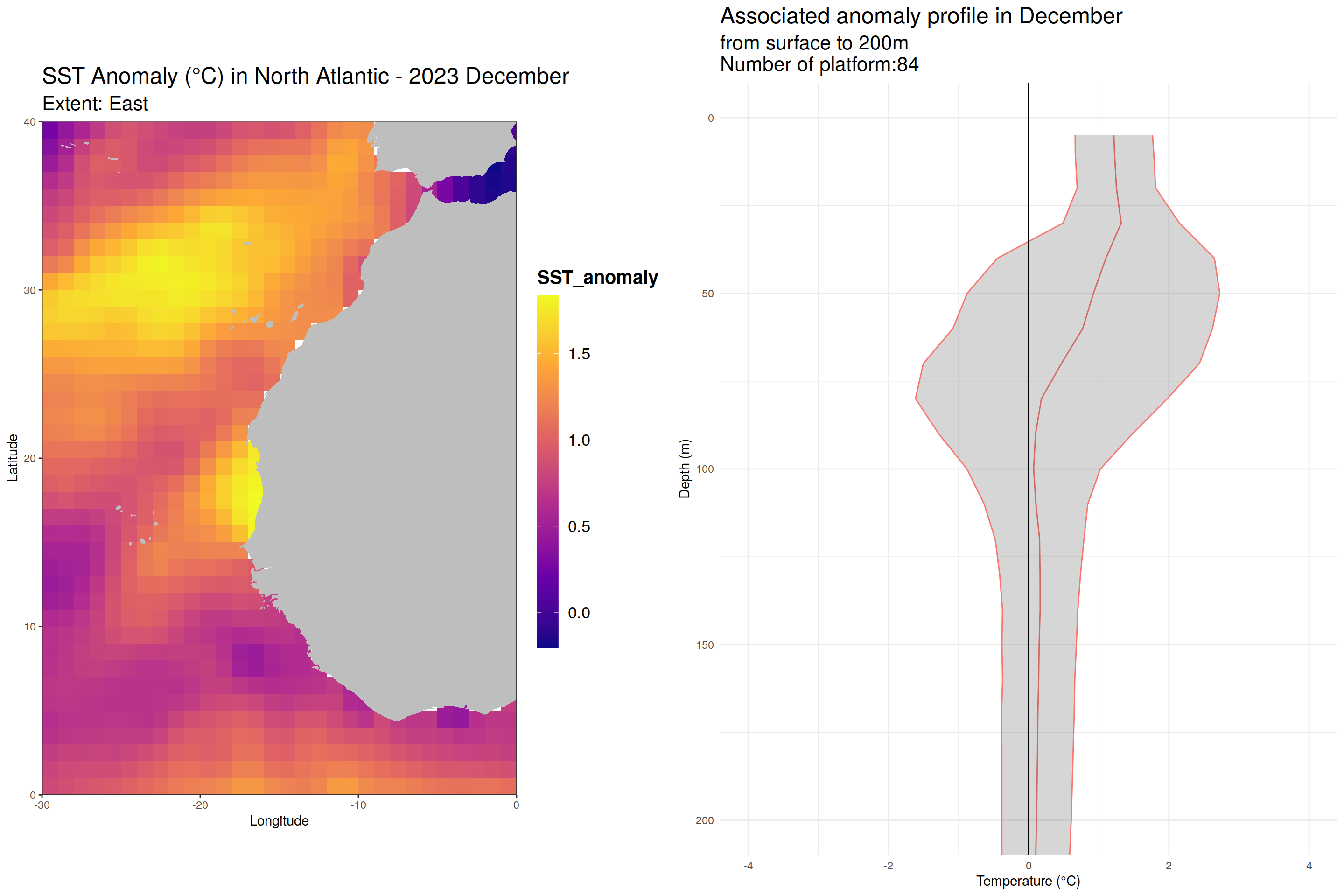
TableGrob (1 x 2) "arrange": 2 grobs
z cells name grob
1 1 (1-1,1-1) arrange gtable[layout]
2 2 (1-1,2-2) arrange gtable[layout]# Monthly vertical anomaly profile for the North Atlantic subset region
ggplot(anomaly_mean, aes(x = temp_anomaly_mean, y = depth, color = factor(month))) +
geom_path() +
geom_ribbon(aes(xmax = temp_anomaly_mean + temp_anomaly_sd,
xmin = temp_anomaly_mean - temp_anomaly_sd,
y = depth), alpha = 0.2) +
geom_vline(xintercept = 0) +
scale_y_reverse() +
coord_cartesian(xlim = c(-4, 4), ylim = c(200, 0)) +
labs(title = paste('Monthly temperature anomaly profile'),
subtitle = paste0("Extent: eastern North Atlantic in 2023"),
x = 'Temperature anomaly [°C]', y = 'Depth [m]') +
theme(plot.title = element_text(size = 18),
plot.subtitle = element_text(size = 16),
axis.title.x = element_text(size = 12),
axis.title.y = element_text(size = 14),
axis.text.x = element_text(size = 12),
axis.text.y = element_text(size = 14),
legend.text = element_text(size = 12),
strip.text = element_text(size = 14),
legend.title = element_text(size = 14, face = "bold"))+
guides(color = FALSE)+
facet_wrap(~month)
#-- Averaging the mean anomaly profiles on a 2 months period
# Creating 2 months period
anomaly_2months <- core_anomaly_2023_natlantic_subset %>%
mutate(period=(as.numeric(month)+1)%/%2)
# Calculating mean anomaly + std dev over the eastern North Atlantic by averaging on a 2month basis
anomaly_2months<-anomaly_2months %>%
group_by(depth, period) %>%
summarise(temp_anomaly_mean = mean(anomaly, na.rm = TRUE),
temp_anomaly_sd = sd(anomaly, na.rm = TRUE))
#Std dev, i.e. of the entire year 2023 in the eastern North Atlantic
anomaly_2023<-core_anomaly_2023_natlantic_subset %>%
group_by(depth) %>%
summarise(temp_anomaly_mean = mean(anomaly, na.rm = TRUE),
temp_anomaly_sd = sd(anomaly, na.rm = TRUE))
# Monthly vertical anomaly profile in the eastern North Atlantic in 2023
ggplot() +
geom_path(data=anomaly_2months, aes(x = temp_anomaly_mean, y = depth, color = factor(period))) +
geom_ribbon(data=anomaly_2023,
aes(xmax = temp_anomaly_mean + temp_anomaly_sd,
xmin = temp_anomaly_mean - temp_anomaly_sd,
y = depth, fill = "spread"), alpha = 0.2) +
geom_vline(xintercept = 0) +
scale_y_reverse() +
coord_cartesian(xlim = c(-4, 4), ylim = c(200, 0)) +
labs(title = paste('Propagation of SST anomalies in the water column'),
subtitle = paste0("Extent: ", name_extent, " North Atlantic bassin in ", target_year),
x = 'Temperature (°C)', y = 'Depth (m)') +
scale_color_manual(values = colorRampPalette(c("blue", "orange", "darkred"))(6), # 2month mean anomalies color
breaks = unique(anomaly_2months$period),
labels =c("Jan-Feb", "March-April", "May-June", "July-Aug", "Sept-Oct", "Nov-Dec")) +
scale_fill_manual(values = "grey", # Spread color
labels = "yearly") +
theme(plot.title = element_text(size = 18),
plot.subtitle = element_text(size = 12),
legend.title = element_text(size = 14),
legend.text = element_text(size = 12)) +
guides(color = guide_legend(title="Period"), fill = guide_legend(title = "Spread")) 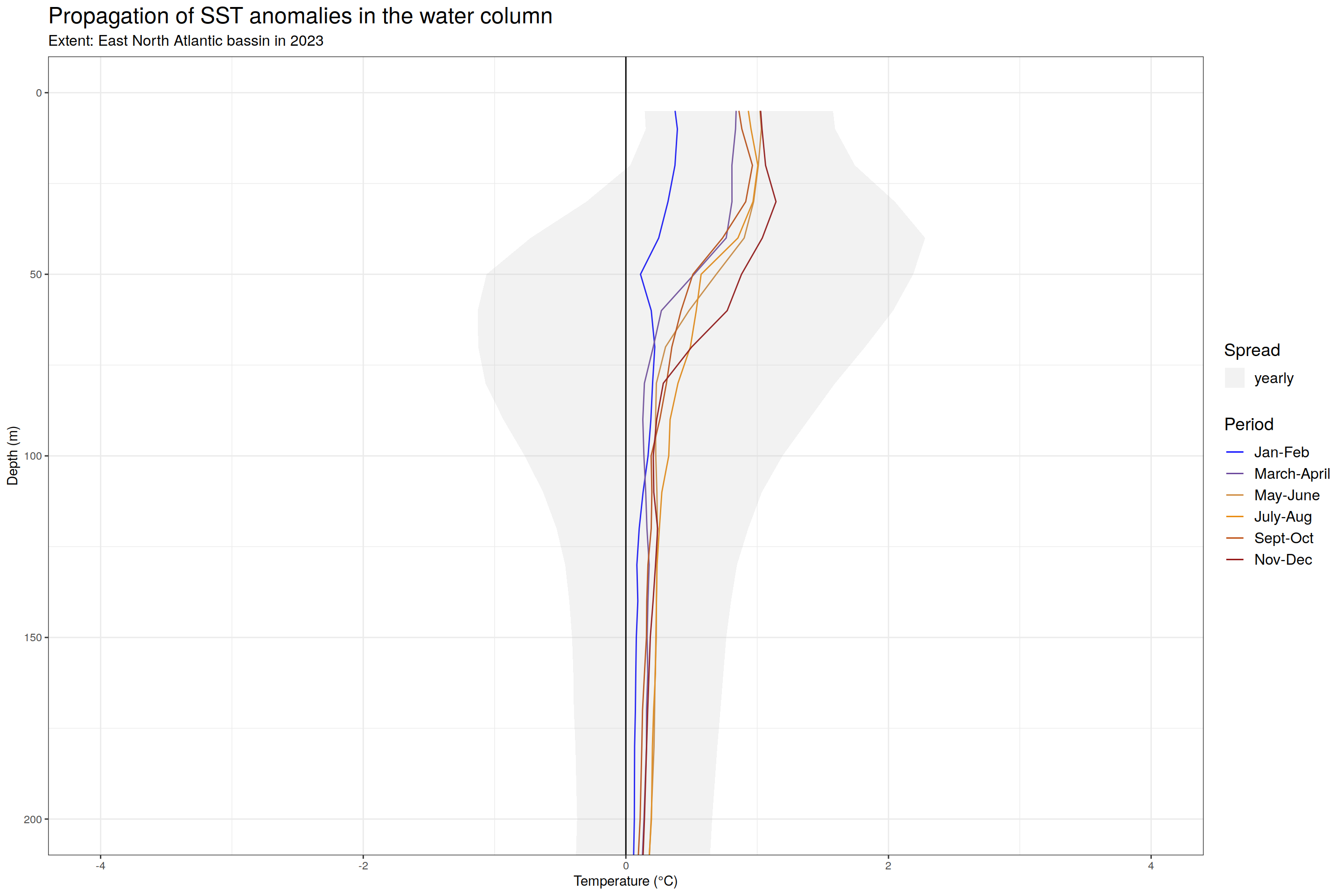
Hovmoeller plot
Analysis of the temporal progression of the MHW penetration using a hovmoeller plot
#---WEEKLY
#adding to the dataset the week of the year
core_anomaly_2023_natlantic_subset <- core_anomaly_2023_natlantic_subset %>%
mutate(week = week(date))
# Calculating weekly mean anomaly over the eastern North Atlantic in 2023
anomaly_weekly<-core_anomaly_2023_natlantic_subset %>%
group_by(depth, week) %>%
summarise(temp_anomaly_mean = mean(anomaly, na.rm = TRUE))
#---2WEEKS
# Calculating 2weekly mean anomaly over the eastern North Atlantic in 2023
anomaly_2weekly <- core_anomaly_2023_natlantic_subset %>%
mutate(week2=(week+1)%/%2) %>% #period of 2weeks
group_by(depth, week2) %>%
summarise(temp_anomaly_mean = mean(anomaly, na.rm = TRUE))
#---MONTHLY
# Calculating monthly mean anomaly over the eastern North Atlantic in 2023
anomaly_monthly <- core_anomaly_2023_natlantic_subset %>%
group_by(depth, month) %>%
summarise(temp_anomaly_mean = mean(anomaly, na.rm = TRUE))
#--- VISUALISATION -- scatterplot of the difference between 2weekly and daily temp anomaly
# difference anomaly weekly-biweekly
anomaly_2weekly_withdate <- core_anomaly_2023_natlantic_subset %>%
mutate(week2 = (week(date) + 1) %/% 2) %>%
group_by(week2, depth) %>%
summarise(temp_count = n(),
temp_anomaly_mean = mean(anomaly, na.rm = TRUE),
start_date = min(date),
end_date = max(date)) %>%
mutate(mid_date = as.integer((yday(start_date) + yday(end_date)) / 2))
# Calculate min and max temperature anomaly for each dataset
daily_max <- max(core_anomaly_2023_natlantic_subset$anomaly, na.rm = TRUE)
daily_min <- min(core_anomaly_2023_natlantic_subset$anomaly, na.rm = TRUE)
biweekly_max <- max(anomaly_2weekly_withdate$temp_anomaly_mean, na.rm = TRUE)
biweekly_min <- min(anomaly_2weekly_withdate$temp_anomaly_mean, na.rm = TRUE)
# Custom labels for the legend
custom_labels <- c(
'Daily' = paste0('Daily (Max: ', round(max(core_anomaly_2023_natlantic_subset$anomaly, na.rm = TRUE), 2),
', Min: ', round(min(core_anomaly_2023_natlantic_subset$anomaly, na.rm = TRUE), 2), ')'),
'Bi-weekly' = paste0('Bi-weekly (Max: ', round(max(anomaly_2weekly_withdate$temp_anomaly_mean, na.rm = TRUE), 2),
', Min: ', round(min(anomaly_2weekly_withdate$temp_anomaly_mean, na.rm = TRUE), 2), ')')
)
# Scatter plot
ggplot() +
geom_point(data = core_anomaly_2023_natlantic_subset,
aes(x = day_of_year, y = anomaly, color = 'Daily'),
alpha = 0.5) +
geom_point(data = anomaly_2weekly_withdate,
aes(x = mid_date, y = temp_anomaly_mean, color = 'Bi-weekly'),
size = 3) +
scale_color_manual(name = "Time Period", values = c('Daily' = '#A256B3', 'Bi-weekly' = 'red'), labels = custom_labels) +
labs(title = 'Comparison of Temperature Anomalies on Daily and Bi-weekly Basis',
subtitle = paste0('Extent: ', name_extent, ', year: ', target_year),
x = 'Day of Year', y = 'Temperature Anomaly (°C)') +
theme_minimal() +
theme(plot.title = element_text(size = 18),
plot.subtitle = element_text(size = 16),
axis.title.x = element_text(size = 14),
axis.title.y = element_text(size = 14),
axis.text.x = element_text(size = 12),
axis.text.y = element_text(size = 12),
legend.text = element_text(size = 12),
legend.title = element_text(size = 14, face = "bold"),
legend.position = 'bottom',
legend.direction = "horizontal",
legend.box = "horizontal")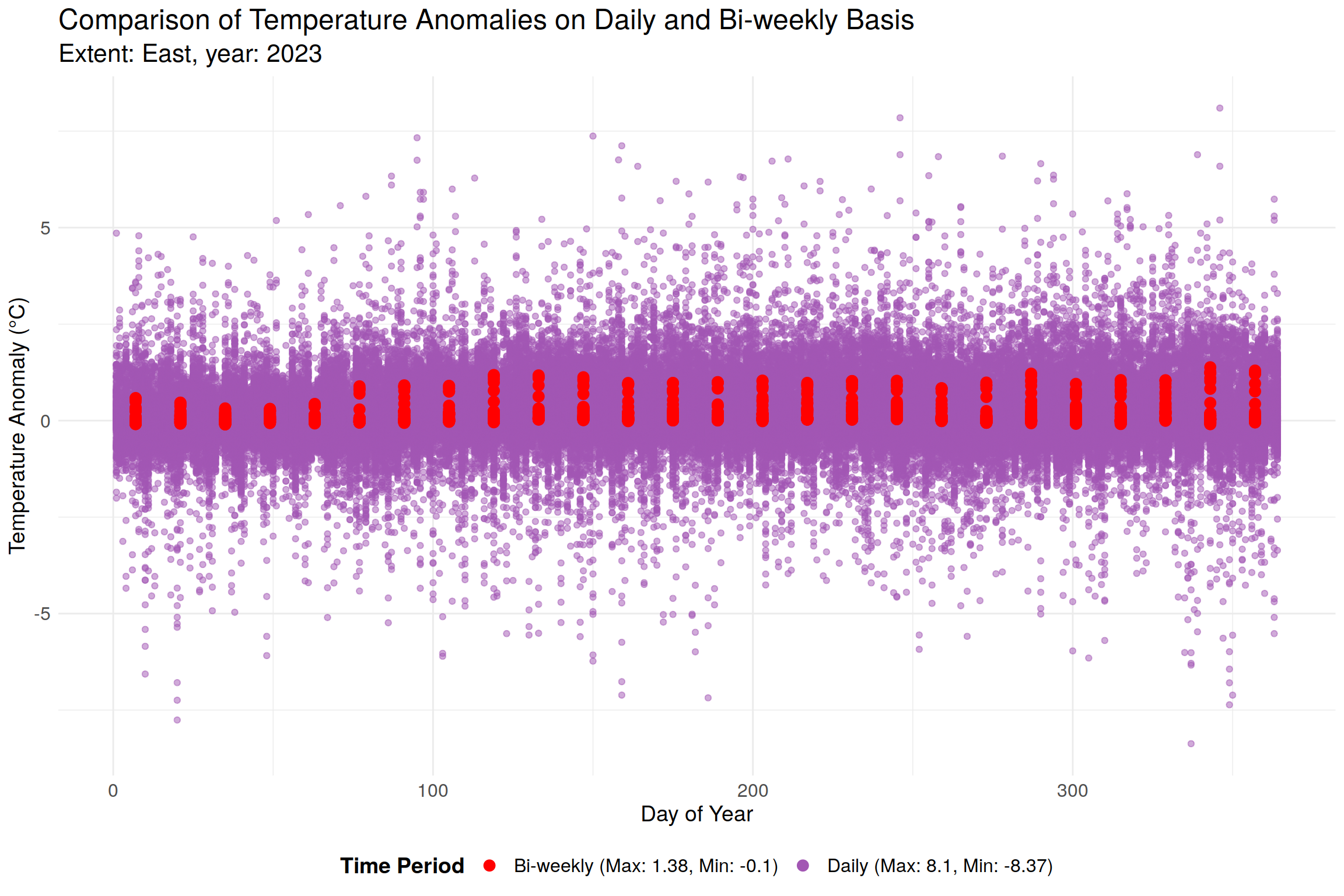
| Version | Author | Date |
|---|---|---|
| 5601558 | mlarriere | 2024-06-13 |
#---Hovmoeller plot
ggplot(data=anomaly_2weekly, aes(x = week2, y = depth, z = temp_anomaly_mean)) +
geom_contour_filled(aes(fill = after_stat(level_mid))) +
scale_fill_gradient2(name='T°C anomaly', low = "darkblue", high = "darkred", #low = "#CED3DC", high = "#906490"
breaks=seq(-0.5, 1.5, by=0.5), labels=as.character(seq(-0.5, 1.5, by=0.5)), limits = c(-0.5, 1.5)) +
coord_cartesian(ylim = c(200, 0), expand = 0) +
labs(title = "Temporal progression of SST anomalies penetration in 2023",
subtitle = paste0("Extent: ", name_extent, ", temporal resolution: 2 weeks"),
x = "Week of Year", y = "Depth (m)") +
theme_minimal() +
theme(plot.title = element_text(size = 18),
plot.subtitle = element_text(size = 16),
axis.title.x = element_text(size = 14),
axis.title.y = element_text(size = 14),
axis.text.x = element_text(size = 12),
axis.text.y = element_text(size = 12),
legend.text = element_text(size = 12),
legend.title = element_text(size = 14, face = "bold"),
legend.key.width = unit(0.5, "cm"),
legend.key.height = unit(3, "cm")
)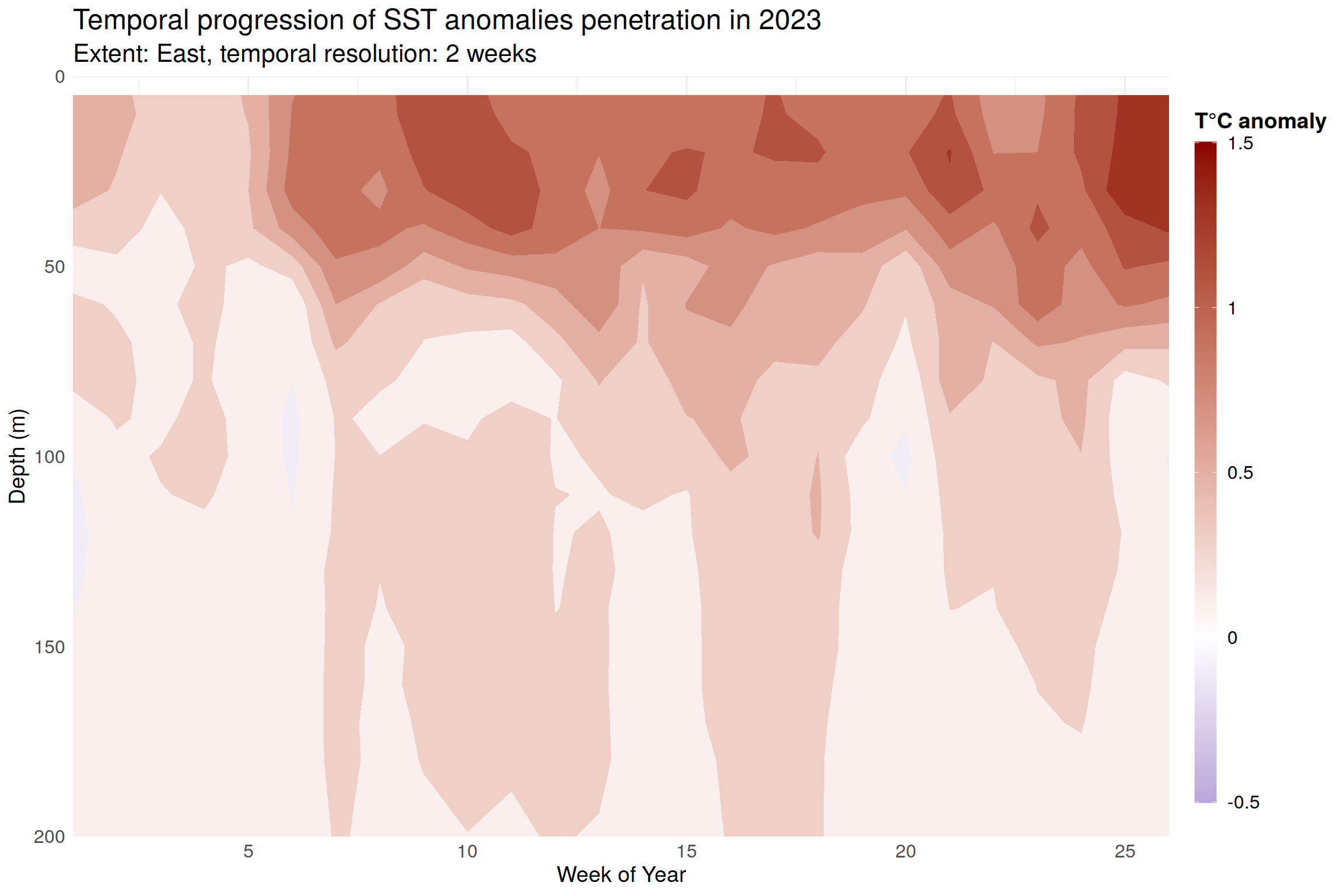
Mixed Layer Depth (MLD)
Load MLD from MIMOC-deBoyer dataset
#Read MLD (created in anomaly_SST_2023.Rmd)
mld_eastern_northAtlantic<- read_rds(paste0(path_argo_core_preprocessed,"/", "mld_",
target_year,"_eastern_NorthAtlantic.rds"))Adding MLD to the Argo observations
#clean dataset
mld_eastern_northAtlantic <-mld_eastern_northAtlantic %>%
select(-date, -time)
#Join the MLD values with the core Argo anomaly profiles
core_anomaly_with_mld_2023<- core_anomaly_with_platform_2023 %>%
inner_join(mld_eastern_northAtlantic, by = c("lat", "lon", "month", "year"))
#Plot the Argo position on a monthly basis with MLD coloring
ggplot()+
geom_tile(data=core_anomaly_with_mld_2023, aes(lon, lat, fill = mld)) +
geom_map(data = world_coordinates, map = world_coordinates, aes(long, lat, map_id = region), fill = "grey") + #base map
lims(x = c(chosen_extent$lon_min, chosen_extent$lon_max), y=c(chosen_extent$lat_min, chosen_extent$lat_max)) + #eastern North Atlantic
scale_fill_viridis_c(option = "magma") +
labs(title = "Mixed Layer Depth",
subtitle= "Monthly average - 2023",
fill = "Mixed Layer Depth [m]")+
coord_quickmap(expand = 0)+
theme(plot.title = element_text(size = 18),
plot.subtitle = element_text(size = 16),
legend.text = element_text(size = 12),
legend.title = element_text(size = 14),
legend.key.width = unit(0.5, "cm"),
legend.key.height = unit(2, "cm")
)+
facet_wrap(~month)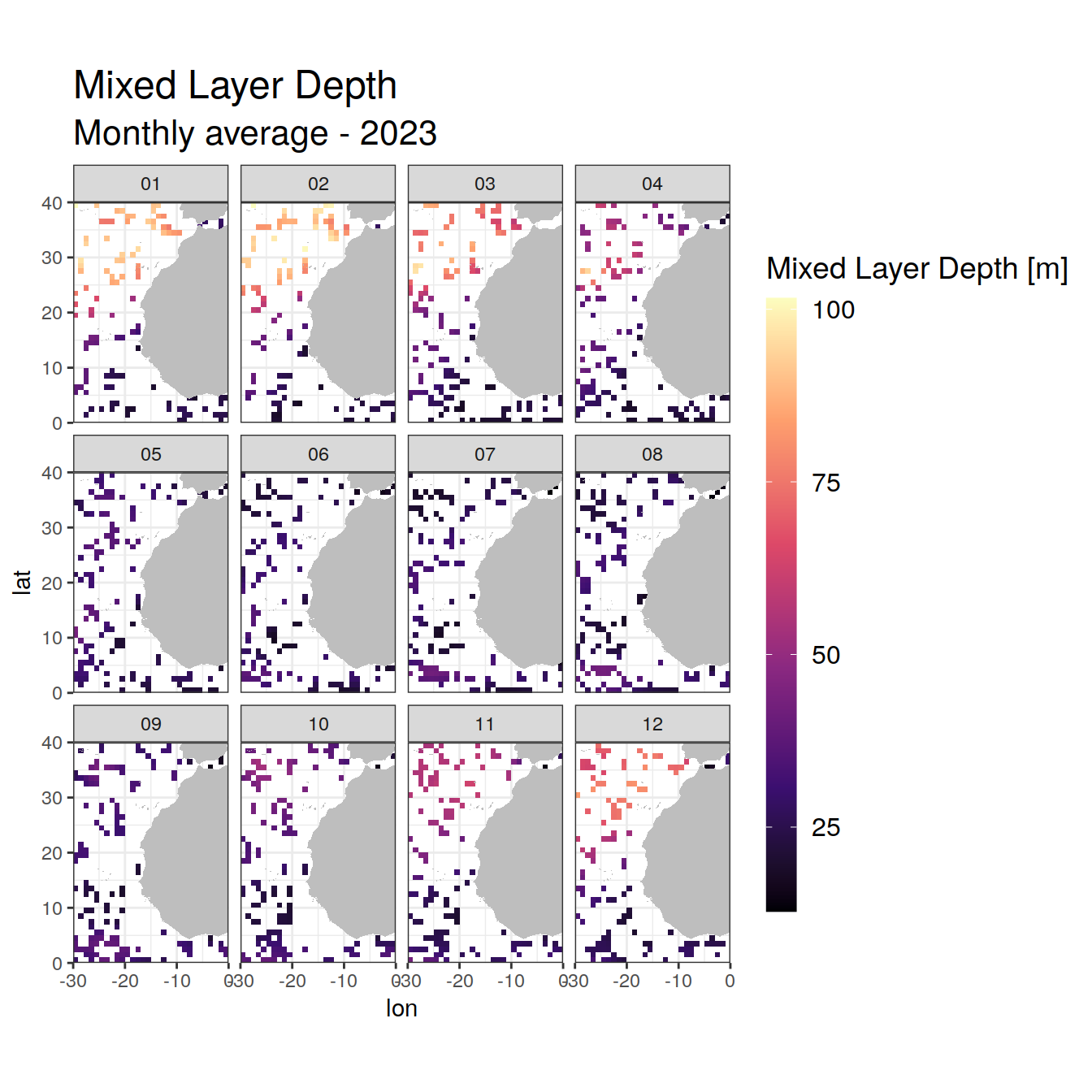
| Version | Author | Date |
|---|---|---|
| 5601558 | mlarriere | 2024-06-13 |
#Plot the vertical temperature profile on a monthly basis with MLD coloring
ggplot() +
geom_path(data=core_anomaly_with_mld_2023, aes(x = anomaly, y = depth,
group = interaction(platform_number, cycle_number), color = mld)) +
geom_vline(xintercept = 0) +
scale_y_reverse() +
scale_color_viridis_c()+
coord_cartesian(xlim = c(-6, 6), ylim = c(200, 0)) +
labs(subtitle = paste('Propagation of SST anomalies in the water column'),
x = 'Temperature anomaly [°C]', y = 'Depth [m]',
color = "MLD \nrange [m]")+
theme(plot.title = element_text(size = 18),
plot.subtitle = element_text(size = 16),
axis.title.x = element_text(size = 14),
axis.title.y = element_text(size = 14),
axis.text.x = element_text(size = 12),
axis.text.y = element_text(size = 12),
legend.text = element_text(size = 12),
legend.title = element_text(size = 14, face = "bold"),
legend.key.width = unit(0.5, "cm"),
legend.key.height = unit(2, "cm")
)+
facet_wrap(~month)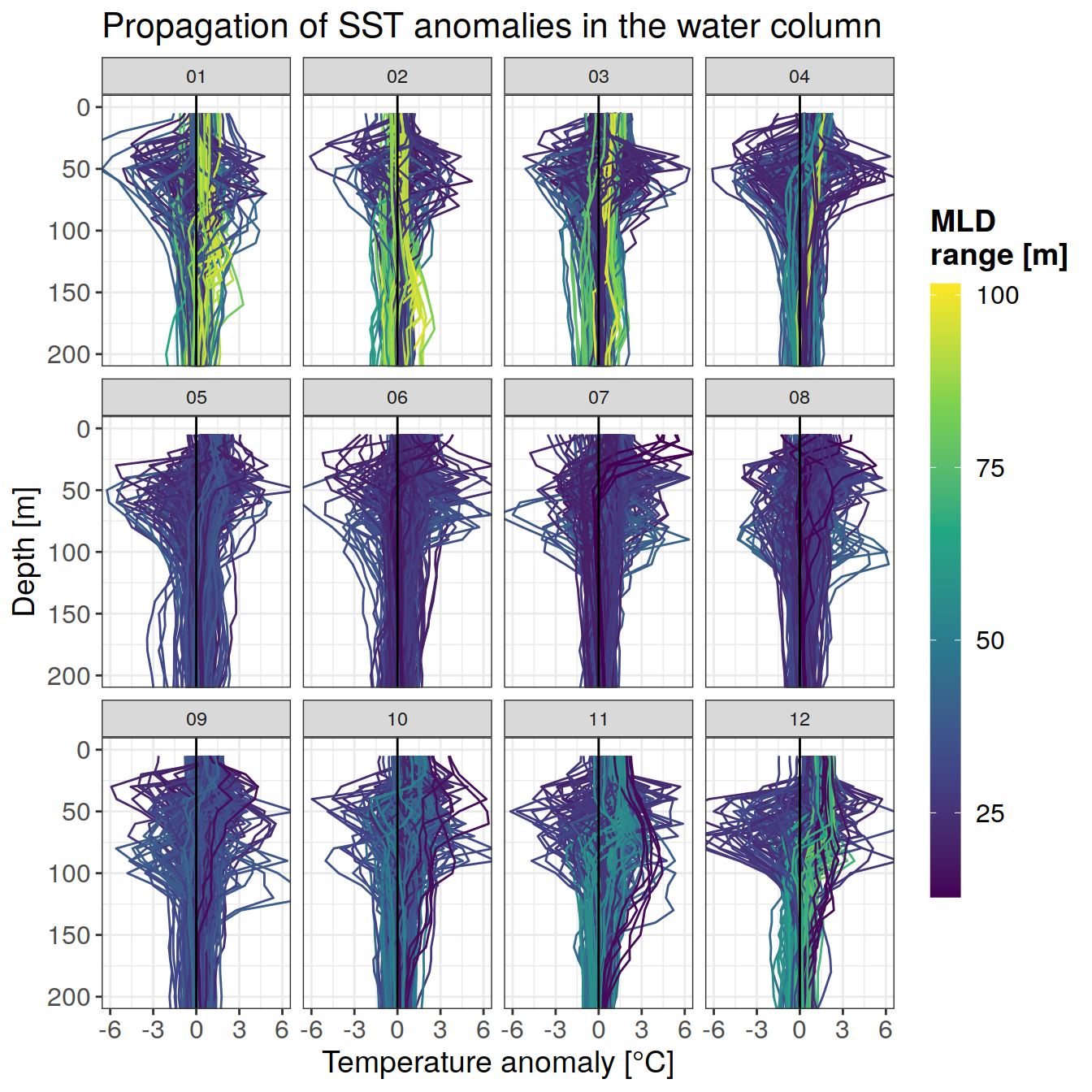
| Version | Author | Date |
|---|---|---|
| 5601558 | mlarriere | 2024-06-13 |
#Group Argo floats depending on MLD: 2 classes above and below 50m
core_anomaly_with_mld_2023_grouped <- core_anomaly_with_mld_2023 %>%
mutate(mld_range = ifelse(mld <= 50, "<=50m", ">50m"))
#Plot core Argo floats location with the 2 mld classes
mld_map<- ggplot()+
geom_tile(data=core_anomaly_with_mld_2023_grouped, aes(lon, lat, fill = mld_range)) +
geom_map(data = world_coordinates, map = world_coordinates, aes(long, lat, map_id = region), fill = "grey") +
lims(x = c(chosen_extent$lon_min, chosen_extent$lon_max), y=c(chosen_extent$lat_min, chosen_extent$lat_max)) +
scale_fill_manual(values = c("<=50m" = "#A1BECE",
">50m" = "#B71518")) +
labs(subtitle = "Argo floats MLD",
x='longitude', y='latitude',
fill = "MLD \nrange [m]")+
coord_quickmap(expand = 0)+
theme(plot.title = element_text(size = 18),
plot.subtitle = element_text(size = 16),
axis.title.x = element_text(size = 14),
axis.title.y = element_text(size = 14),
axis.text.x = element_text(size = 12),
axis.text.y = element_text(size = 12),
legend.text = element_text(size = 18),
legend.title = element_text(size = 18, face = "bold"),
legend.key.width = unit(0.5, "cm"),
legend.key.height = unit(2, "cm")
)+
facet_wrap(~month)
# Calculating monthly mean anomaly over the eastern North Atlantic in 2023 as function of MLD classes
anomaly_core_with_mld_monthly_mean<-core_anomaly_with_mld_2023_grouped %>%
group_by(depth, month, mld_range) %>%
summarise(temp_anomaly_mean = mean(anomaly, na.rm = TRUE))
vertical_profiles<- ggplot() +
geom_path(data=core_anomaly_with_mld_2023_grouped, aes(x = anomaly, y = depth,
group = interaction(platform_number, cycle_number), color = mld_range)) +
geom_vline(xintercept = 0) +
scale_y_reverse() +
coord_cartesian(xlim = c(-4, 4), ylim = c(200, 0)) +
labs(subtitle = paste('Propagation of SST anomalies in the water column'),
x = 'Temperature anomaly [°C]', y = 'Depth [m]') +
scale_color_manual(values = c("<=50m" = "#A1BECE",
">50m" = "#B71518")) +
theme(plot.title = element_text(size = 18),
plot.subtitle = element_text(size = 16),
axis.title.x = element_text(size = 14),
axis.title.y = element_text(size = 14),
axis.text.x = element_text(size = 12),
axis.text.y = element_text(size = 12),
legend.position = 'none')+
facet_wrap(~month)+
guides(color = guide_legend(title="MLD range [m]"))
combined_plot <- vertical_profiles + mld_map +
plot_layout(ncol = 2) +
plot_annotation(
title = 'Core Argo floats with MLD on a monthly basis',
subtitle = 'Eastern North Atlantic in 2023',
theme = theme(plot.title = element_text(size = 18),
plot.subtitle = element_text(size = 16))
)
combined_plot
# Calculate the median MLD value for each month
monthly_median_mld <- core_anomaly_with_mld_2023 %>%
group_by(year, month) %>%
summarise(median_mld = median(mld))
# Join the median MLD values to the original dataframe
core_anomaly_with_mld_2023 <- core_anomaly_with_mld_2023 %>%
left_join(monthly_median_mld, by = c("year", "month"))
# MLD category: MLD above or below monthly threshold
core_anomaly_with_mld_2023 <- core_anomaly_with_mld_2023 %>%
mutate(mld_category = ifelse(mld > median_mld, "above median", "below median"))
# Facet labels with month + monthly median MLD
core_anomaly_with_mld_2023 <- core_anomaly_with_mld_2023 %>%
mutate(facet_label = paste(month, "\nMedian MLD:", round(median_mld, 2)))
# Plot
mld_plot <- ggplot(core_anomaly_with_mld_2023, aes(x = lon, y = lat, fill = mld_category)) +
geom_tile() +
geom_map(data = world_coordinates, map = world_coordinates, aes(long, lat, map_id = region), fill = "grey") +
lims(x = c(chosen_extent$lon_min, chosen_extent$lon_max), y = c(chosen_extent$lat_min, chosen_extent$lat_max)) +
labs(title = paste("MLD Maps for", target_year),
subtitle = paste("The MLD category correpond to the median MLD for each month, \ni.e. same number of Argo floats in each category"),
x = "Longitude", y = "Latitude", fill = "MLD category") +
scale_fill_manual(values = c("below median" = "lightblue", "above median" = "darkred")) +
theme(plot.title = element_text(size = 18),
plot.subtitle = element_text(size = 16),
axis.title.x = element_text(size = 14),
axis.title.y = element_text(size = 14),
axis.text.x = element_text(size = 12),
axis.text.y = element_text(size = 12),
strip.text = element_text(size = 14),
legend.text = element_text(size = 12)) +
facet_wrap(~ facet_label, ncol = 3) +
theme_bw()
vertical_profiles<- ggplot() +
geom_path(data=core_anomaly_with_mld_2023, aes(x = anomaly, y = depth, group = interaction(platform_number, cycle_number), color = mld_category)) +
geom_vline(xintercept = 0) +
scale_y_reverse() +
coord_cartesian(xlim = c(-6, 6), ylim = c(200, 0)) +
labs(subtitle = paste('Propagation of SST anomalies in the water column'),
x = 'Temperature anomaly [°C]', y = 'Depth [m]') +
scale_color_manual(values = c("below median" = "lightblue", "above median" = "darkred")) +
theme(plot.title = element_text(size = 18),
plot.subtitle = element_text(size = 16),
axis.title.x = element_text(size = 14),
axis.title.y = element_text(size = 14),
axis.text.x = element_text(size = 12),
axis.text.y = element_text(size = 12),
strip.text = element_text(size = 14),
legend.position = 'none')+
facet_wrap(~ facet_label, ncol = 3)
combined_plot <- vertical_profiles + mld_plot +
plot_layout(ncol = 2) +
plot_annotation(
title = 'Core Argo floats with MLD on a monthly basis',
subtitle = 'Eastern North Atlantic in 2023',
theme = theme(
plot.title = element_text(size = 18),
plot.subtitle = element_text(size = 16)
)
)
combined_plot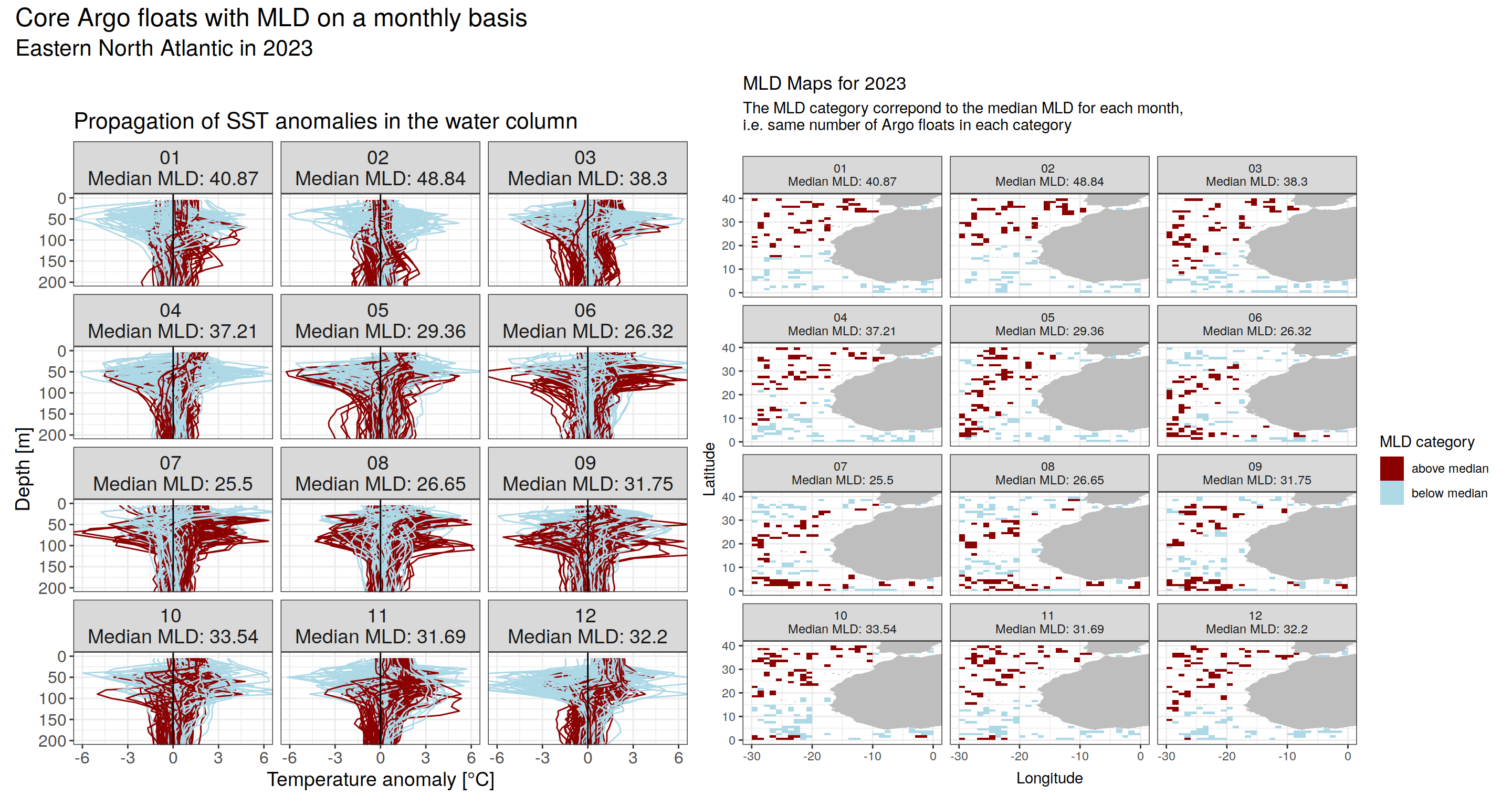
Absolute maximum anomalies
#Absolute max anomalies for each lat-lon (1 value for each lat-lon pair)
abs_max_SSTanomalies<-core_anomaly_2023_natlantic_subset %>%
filter(!is.na(anomaly), depth<=200) %>%
group_by(lat, lon) %>%
summarize(max_SST_anomaly = max(abs(anomaly), na.rm = TRUE))
plot1<-ggplot()+
geom_tile(data=abs_max_SSTanomalies, aes(lon, lat, fill = max_SST_anomaly)) +
geom_map(data = world_coordinates, map = world_coordinates, aes(long, lat, map_id = region), fill = "grey") +
lims(x = c(chosen_extent$lon_min, chosen_extent$lon_max), y=c(chosen_extent$lat_min, chosen_extent$lat_max)) +
scale_fill_viridis_c(option = "magma") +
labs(title = "Absolute maximum SST anomaly",
subtitle= "Annual average - 2023",
fill = "Absolute max \nSST anomalies [°C]")+
coord_quickmap(expand = 0)+
theme(plot.title = element_text(size = 18),
plot.subtitle = element_text(size = 16),
axis.title.x = element_text(size = 14),
axis.title.y = element_text(size = 14),
axis.text.x = element_text(size = 12),
axis.text.y = element_text(size = 12),
strip.text = element_text(size = 14),
legend.text = element_text(size = 12),
legend.title = element_text(size = 14),
legend.key.width = unit(0.5, "cm"),
legend.key.height = unit(2, "cm")
)
#Mean depth at which max anomaly is found (maximum depth for each lat-lon pair)
mean_depth_max_anomaly<- inner_join(abs_max_SSTanomalies, core_anomaly_2023_natlantic_subset, by=c('lat', 'lon'))
mean_depth_max_anomaly <- mean_depth_max_anomaly %>%
filter(abs(anomaly) == max_SST_anomaly)
plot2<-ggplot()+
geom_tile(data=mean_depth_max_anomaly, aes(lon, lat, fill = depth)) +
geom_map(data = world_coordinates, map = world_coordinates, aes(long, lat, map_id = region), fill = "grey") +
lims(x = c(chosen_extent$lon_min, chosen_extent$lon_max), y=c(chosen_extent$lat_min, chosen_extent$lat_max)) +
scale_fill_scico(palette = "lajolla", direction = -1) +
labs(title = "Depth of maximum anomaly [m]",
subtitle = 'depth range: 0-200m',
fill = "Depth [m]")+
coord_quickmap(expand = 0)+
theme(plot.title = element_text(size = 18),
plot.subtitle = element_text(size = 16),
axis.title.x = element_text(size = 14),
axis.title.y = element_text(size = 14),
axis.text.x = element_text(size = 12),
axis.text.y = element_text(size = 12),
strip.text = element_text(size = 14),
legend.text = element_text(size = 12),
legend.title = element_text(size = 14),
legend.key.width = unit(0.5, "cm"),
legend.key.height = unit(2, "cm"))
combined_plot<-plot1+plot2
combined_plot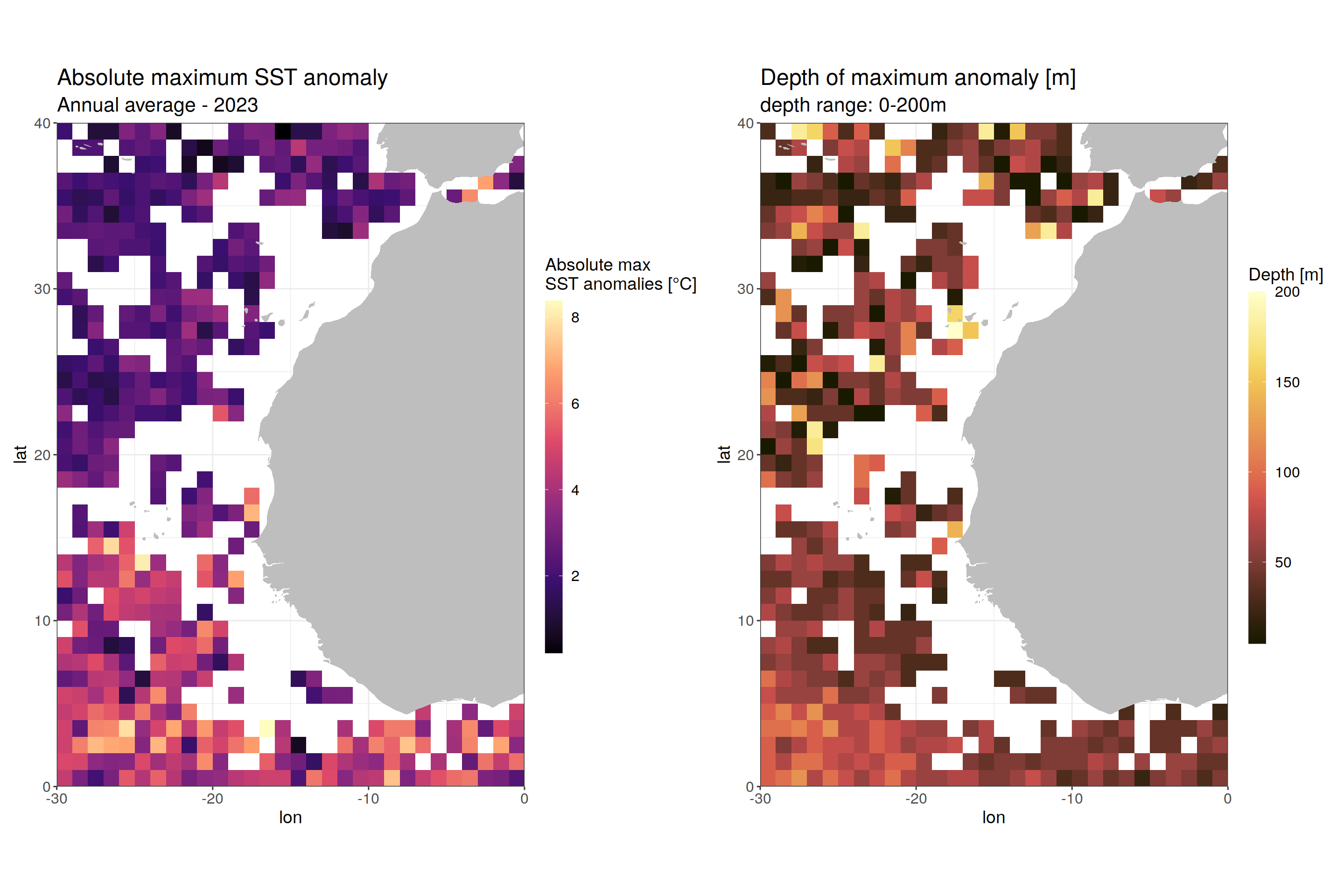
sessionInfo()R version 4.2.2 (2022-10-31)
Platform: x86_64-pc-linux-gnu (64-bit)
Running under: openSUSE Leap 15.5
Matrix products: default
BLAS: /usr/local/R-4.2.2/lib64/R/lib/libRblas.so
LAPACK: /usr/local/R-4.2.2/lib64/R/lib/libRlapack.so
locale:
[1] LC_CTYPE=en_US.UTF-8 LC_NUMERIC=C
[3] LC_TIME=en_US.UTF-8 LC_COLLATE=en_US.UTF-8
[5] LC_MONETARY=en_US.UTF-8 LC_MESSAGES=en_US.UTF-8
[7] LC_PAPER=en_US.UTF-8 LC_NAME=C
[9] LC_ADDRESS=C LC_TELEPHONE=C
[11] LC_MEASUREMENT=en_US.UTF-8 LC_IDENTIFICATION=C
attached base packages:
[1] stats graphics grDevices utils datasets methods base
other attached packages:
[1] scico_1.3.1 patchwork_1.1.2 broom_1.0.5
[4] paletteer_1.6.0 cluster_2.1.6 gridExtra_2.3
[7] scatterplot3d_0.3-44 viridis_0.6.2 viridisLite_0.4.1
[10] ggOceanMaps_1.3.4 ggspatial_1.1.7 oce_1.7-10
[13] gsw_1.1-1 lubridate_1.9.0 timechange_0.1.1
[16] forcats_0.5.2 stringr_1.5.0 dplyr_1.1.3
[19] purrr_1.0.2 readr_2.1.3 tidyr_1.3.0
[22] tibble_3.2.1 ggplot2_3.4.4 tidyverse_1.3.2
[25] workflowr_1.7.0
loaded via a namespace (and not attached):
[1] googledrive_2.0.0 colorspace_2.0-3 ellipsis_0.3.2
[4] class_7.3-20 rprojroot_2.0.3 fs_1.5.2
[7] rstudioapi_0.15.0 proxy_0.4-27 farver_2.1.1
[10] fansi_1.0.3 xml2_1.3.3 codetools_0.2-18
[13] cachem_1.0.6 knitr_1.41 jsonlite_1.8.3
[16] dbplyr_2.2.1 rgeos_0.5-9 compiler_4.2.2
[19] httr_1.4.4 backports_1.4.1 assertthat_0.2.1
[22] fastmap_1.1.0 gargle_1.2.1 cli_3.6.1
[25] later_1.3.0 htmltools_0.5.8.1 tools_4.2.2
[28] gtable_0.3.1 glue_1.6.2 maps_3.4.1
[31] Rcpp_1.0.10 cellranger_1.1.0 jquerylib_0.1.4
[34] RNetCDF_2.6-1 raster_3.6-11 vctrs_0.6.4
[37] lwgeom_0.2-10 xfun_0.35 ps_1.7.2
[40] rvest_1.0.3 lifecycle_1.0.3 ncmeta_0.3.5
[43] googlesheets4_1.0.1 terra_1.7-65 getPass_0.2-2
[46] scales_1.2.1 hms_1.1.2 promises_1.2.0.1
[49] parallel_4.2.2 rematch2_2.1.2 yaml_2.3.6
[52] sass_0.4.4 stringi_1.7.8 highr_0.9
[55] e1071_1.7-12 rlang_1.1.1 pkgconfig_2.0.3
[58] evaluate_0.18 lattice_0.20-45 sf_1.0-9
[61] labeling_0.4.2 processx_3.8.0 tidyselect_1.2.0
[64] magrittr_2.0.3 R6_2.5.1 generics_0.1.3
[67] DBI_1.2.2 pillar_1.9.0 haven_2.5.1
[70] whisker_0.4 withr_2.5.0 units_0.8-0
[73] stars_0.6-0 abind_1.4-5 sp_1.5-1
[76] modelr_0.1.10 crayon_1.5.2 KernSmooth_2.23-20
[79] utf8_1.2.2 tzdb_0.3.0 rmarkdown_2.18
[82] isoband_0.2.6 grid_4.2.2 readxl_1.4.1
[85] callr_3.7.3 git2r_0.30.1 reprex_2.0.2
[88] digest_0.6.30 classInt_0.4-8 httpuv_1.6.6
[91] munsell_0.5.0 bslib_0.4.1